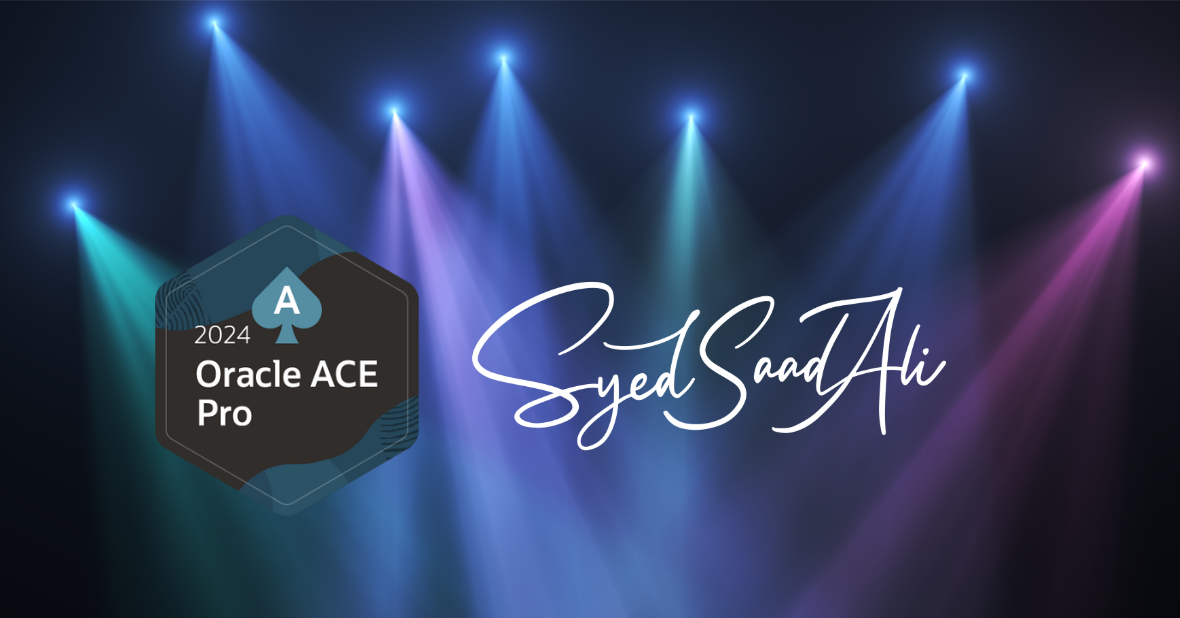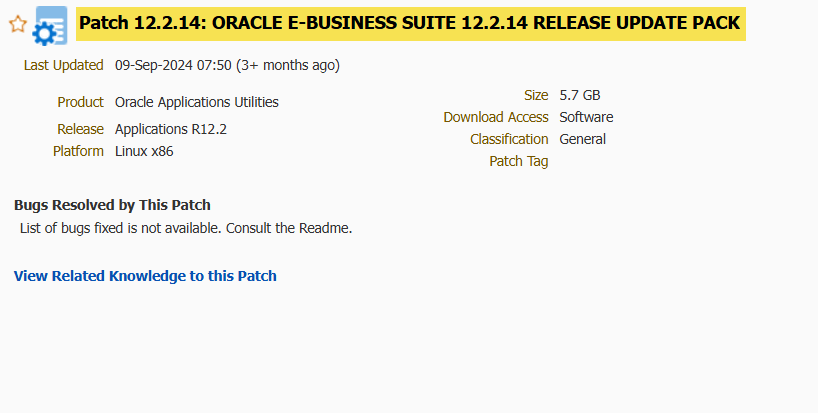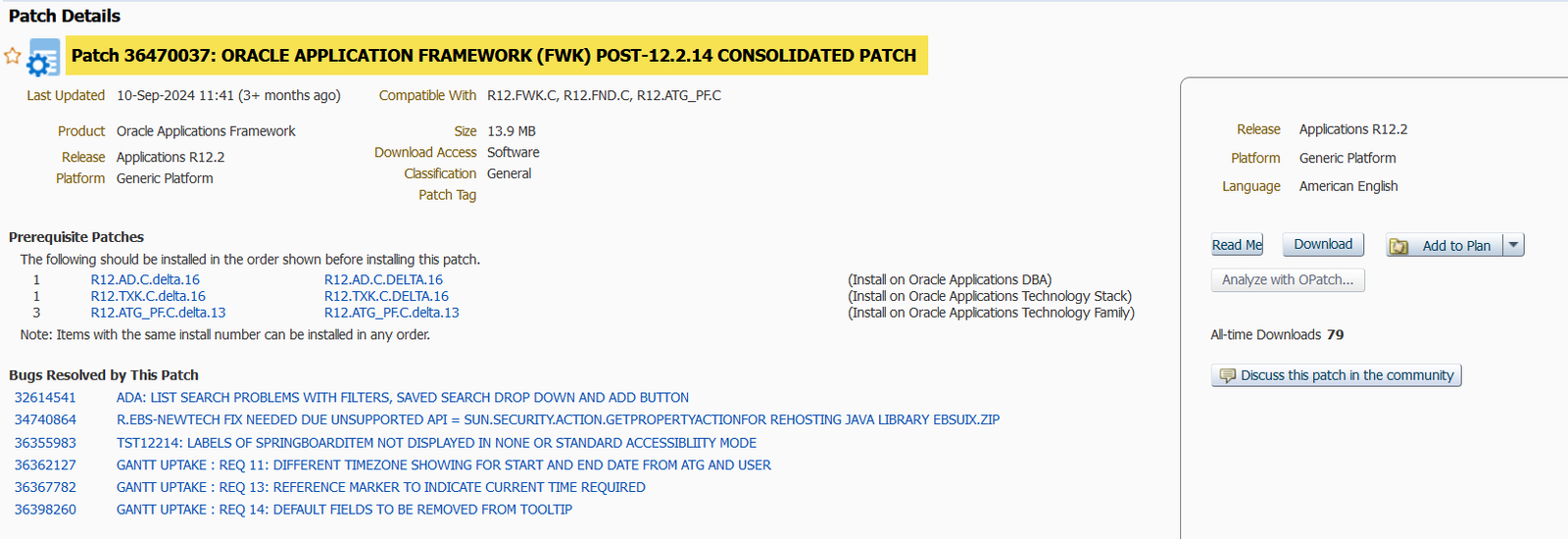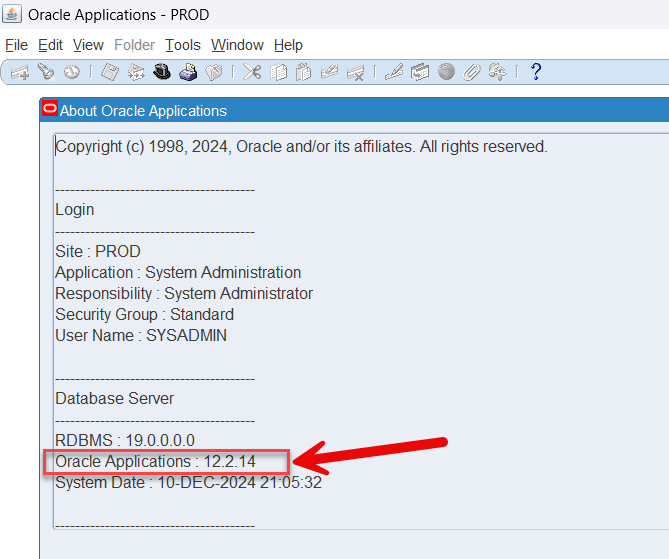Oracle ACE Pro
Oracle Solution Architect
Oracle E-Business Suite
Oracle Cloud Infrastructure
Oracle Fusion Middleware
Oracle Database Administration
Oracle Weblogic Administration
Oracle ACE Pro
Oracle Solution Architect
Oracle E-Business Suite
Oracle Cloud Infrastructure
Oracle Fusion Middleware
Oracle Database Administration
Oracle Weblogic Administration
Month: December 2024
Oracle Fusion Middleware 12.2.1.4 Introduction
-
What is Oracle Fusion Middleware 12.2.1.4?
Oracle Fusion Middleware 12.2.1.4 is a set of software tools and services that help businesses build and run applications. It acts as a bridge between different systems, making it easier to connect, manage, and secure enterprise applications whether they are in the cloud, on-premises, or both.
-
What Does It Do?
- Develop Applications: Provides tools to create modern web, mobile, and enterprise applications.
- Integrate Systems: Connects different software and systems so they work together.
- Manage Content: Organizes documents and web portals for easy collaboration.
- Analyze Data: Includes tools to generate reports and make data-driven decisions.
- Secure Access: Manages user logins and permissions to protect sensitive information.
-
Key Components
- Oracle WebLogic Server: The foundation for running applications reliably and efficiently.
- Oracle SOA Suite: Helps combine services (like APIs) into workflows for seamless integration.
- Oracle WebCenter: Used to manage digital content and create user-friendly portals.
- Oracle Identity Management: Ensures secure user authentication and authorization.
- Oracle Business Intelligence (BI): Provides dashboards and reports for analyzing business performance.
-
Why Use It?
- Flexibility: It works in hybrid environments, combining cloud and on-premises systems.
- Scalability: Handles small applications to large, complex enterprise systems.
- Efficiency: Speeds up application development and deployment.
- Enhanced Security: Centralized tools protect apps and user data.
- Improved Integration: Makes different systems work as one unified solution.
-
Benefits for Businesses
- Reduces complexity by centralizing tools and systems.
- Increases productivity by automating workflows and simplifying integration.
- Provides actionable insights to make better decisions.
- Ensures systems remain secure and compliant.
Summary
Oracle Fusion Middleware 12.2.1.4 is a comprehensive platform designed to help businesses build, integrate, and secure applications while enabling advanced collaboration, analytics, and scalability. It’s ideal for organizations managing diverse IT systems in a hybrid environment.
Oracle Documentation To Be Used for FMW,OID,ODIP 12.2.1.4Ø Oracle Identity & Access Management Certification Matrix Oracle Fusion Middleware 12.2.1.4 Certification Matrix Ø Install Oracle Fusion Middleware Infrastructure Oracle Fusion Middleware 12.2.1.4 Ø Installing and Configuring the Oracle Access Management Software ORACLE ACCESS MANGER 12.2.1.4 |
FMW Infrastructure Installation
1 Create OAM Operating System User
| [root@oamserver ~]# useradd -g oinstall -G dba -d /home/oammgr -m -s /bin/bash oammgr
[root@oamserver ~]# passwd oammgr Changing password for user oammgr. New password: Retype new password: passwd: all authentication tokens updated successfully. [root@oamserver ~]# [root@oamserver u02]# chown -R oammgr:oinstall /u02 |
2. Untar the JDK
| [oammgr@oamserver u02]$ tar -xvzf jdk-8u361-linux-x64.tar.gz [oammgr@oamserver ~]$ cd /u02/jdk1.8.0_361/bin |
3. Unzip the FMW12.2.1.4
| [oammgr@oamserver fmw_infrastructure]$ ll total 1597388 -rwxrwxrwx. 1 oammgr oinstall 1635717400 Nov 17 22:35 V998828-01.zip [oammgr@oamserver fmw_infrastructure]$ unzip -qo V998828-01.zip [oammgr@oamserver fmw_infrastructure]$ ll total 3195068 -r-xr-xr-x. 1 oammgr oinstall 1636007590 Sep 13 2019 fmw_12.2.1.4.0_infrastructure.jar -rw-r–r–. 1 oammgr oinstall 10185 Sep 16 2019 fmw_12214_readme.html -rwxrwxrwx. 1 oammgr oinstall 1635717400 Nov 17 22:35 V998828-01.zip |
4. Running Installer FMW12.2.1.4
The 12c installation starts with the common infrastructure which contains Weblogic, the RCU, and other common components.
Start the installation with the command ‘java -jar fmw_12.2.1.4.0_infrastructure.jar for version 12.2.1.4.
| [oammgr@oamserver ~]$ cd /u02/jdk1.8.0_361/bin/ [oammgr@oamserver bin]$ export DISPLAY=192.168.1.123:0.0 [oammgr@oamserver bin]$ ./java -jar /u02/fmw_infrastructure/fmw_12.2.1.4.0_infrastructure.jar |

Click Next

- Click Skip Auto Updates
- Click Next

- On this step, set the value for ORACLE_HOME, which is to be the location of core installed files.
- Click Next

- For the next step leave the ‘FUSION MIDDLEWARE INFRASTRUCTURE‘ selected.
- Click Next

- Click Next

- Verify the settings on the Installation Summary screen.
- To change entries, Click BACK on the pertinent screen.
- Once satisfied with the settings, click the INSTALL button to begin the installation.

- Installation Started

- Click Next

- Click Finish

Oracle Database 19c Installation on OEL 8.10
Operating System Setup
1. For Automatic Setup of Operating System Packages and Parameters, Run the following command with Root user
[root@oidserver ~]# dnf install -y oracle-database-preinstall-19c
| If you are using RHEL8 or CentOS8, you can pick up the RPM from the OL8 repository and install it. It will pull the dependencies from your normal repositories.
curl -o oracle-database-preinstall-19c-1.0-2.el8.x86_64.rpm https://yum.oracle.com/repo/OracleLinux/OL8/appstream/x86_64/getPackage/oracle-database-preinstall-19c-1.0-2.el8.x86_64.rpm dnf -y localinstall oracle-database-preinstall-19c-1.0-2.el8.x86_64.rpm |
2. Set the password for the “oracle” user.
[root@oamserver ~]# passwd oracle
3. Set secure Linux to permissive by editing the “/etc/selinux/config” file, making sure the SELINUX flag is set as follows.
SELINUX=permissive
4. Once the change is complete, restart the server or run the following command.
[root@oamserver ~]# setenforce Permissive
5. Once the change is complete, restart the server or run the following command.
If you have the Linux firewall enabled, you will need to disable or configure it. To disable it, do the following.
# systemctl stop firewalld
# systemctl disable firewalld
6. Create the directories in which the Oracle software will be installed.
[root@oamserver ~]# mkdir -p /u01/app/oracle/product/19.0.0/dbhome_1
[root@oamserver ~]# chown -R oracle:oinstall /u01/app
[root@oamserver ~]# chmod -R 775 /u01
7. Create an Environment Variable file for the Oracle Database on the Oracle User Home Directory
| [oracle@oamserver ~]$ vi setEnv.sh
# Oracle Settings export ORACLE_HOSTNAME=oidserver.com export PATH=/usr/sbin:/usr/local/bin:$PATH export LD_LIBRARY_PATH=$ORACLE_HOME/lib:/lib:/usr/lib |
8. Unzip Software Binaries
Copy the Downloaded Database 19c Zip (V982063-01.zip) file on the /u01/app/oracle/product/19.0.0/dbhome_1 Directory
[oracle@oamserver ~]$ cd /u01/app/oracle/product/19.0.0/dbhome_1
[oracle@oamserver dbhome_1]$ unzip -oq V982063-01.zip
Running Database Installer
| [oracle@oamserver dbhome_1]$ export DISPLAY=192.168.1.124:0.0 [oracle@oamserver dbhome_1]$ export CV_ASSUME_DISTID=OEL7.8 [oracle@oamserver dbhome_1]$ ./runInstaller The response file for this session can be found at: You can find the log of this install session at: |
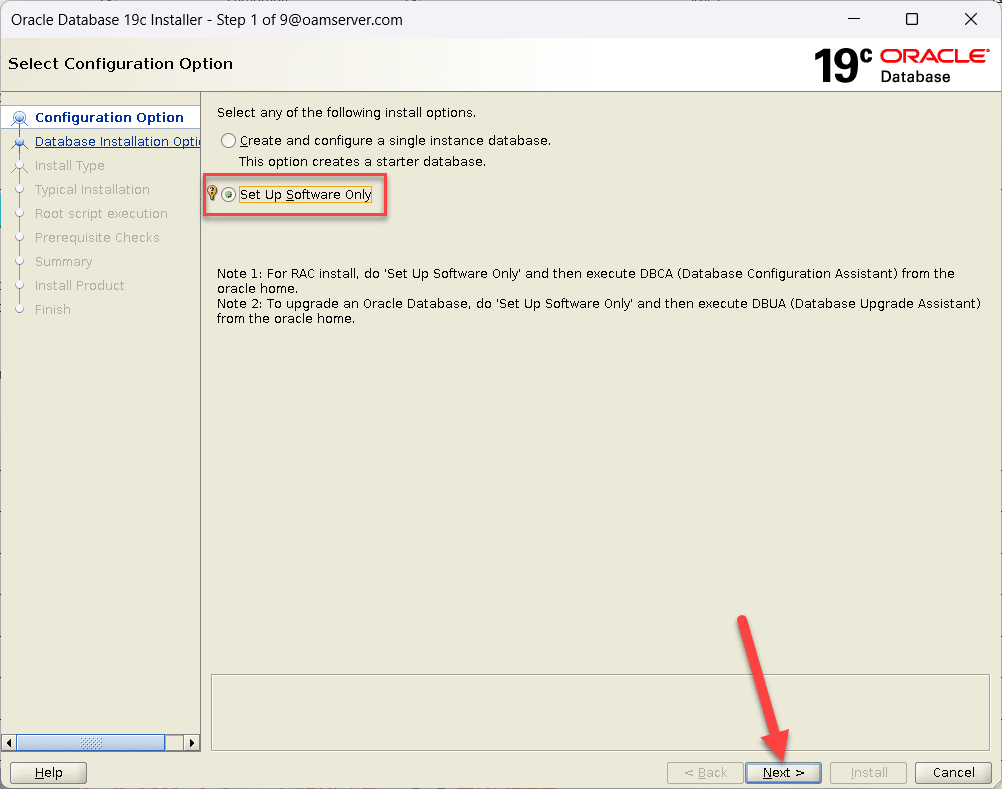
| Select Single Instance Database Installation
Click Next |
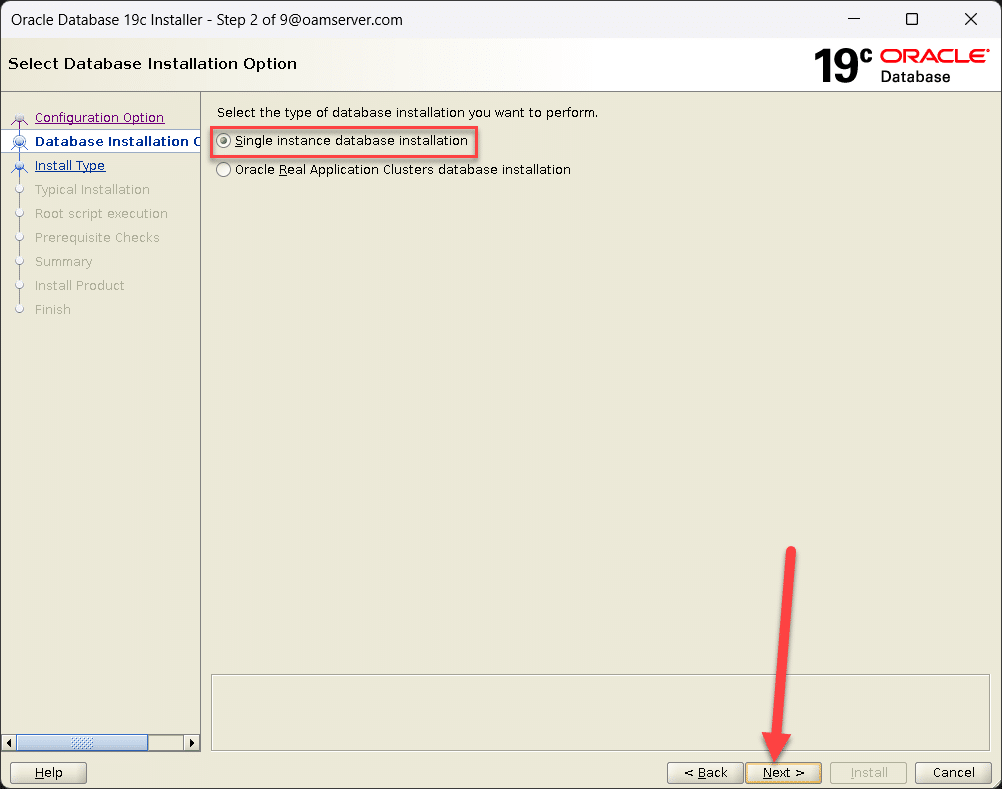 |
| Select Enterprise Edition
Click Next |
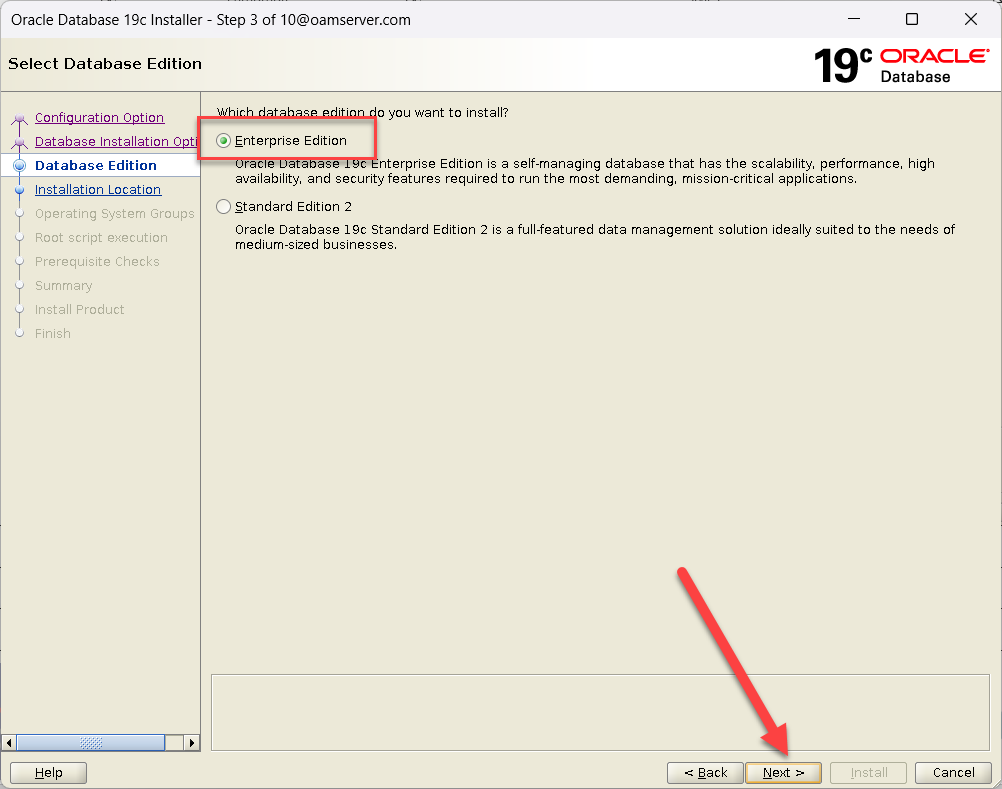 |
| Confirm Oracle Base Location
Click Next |
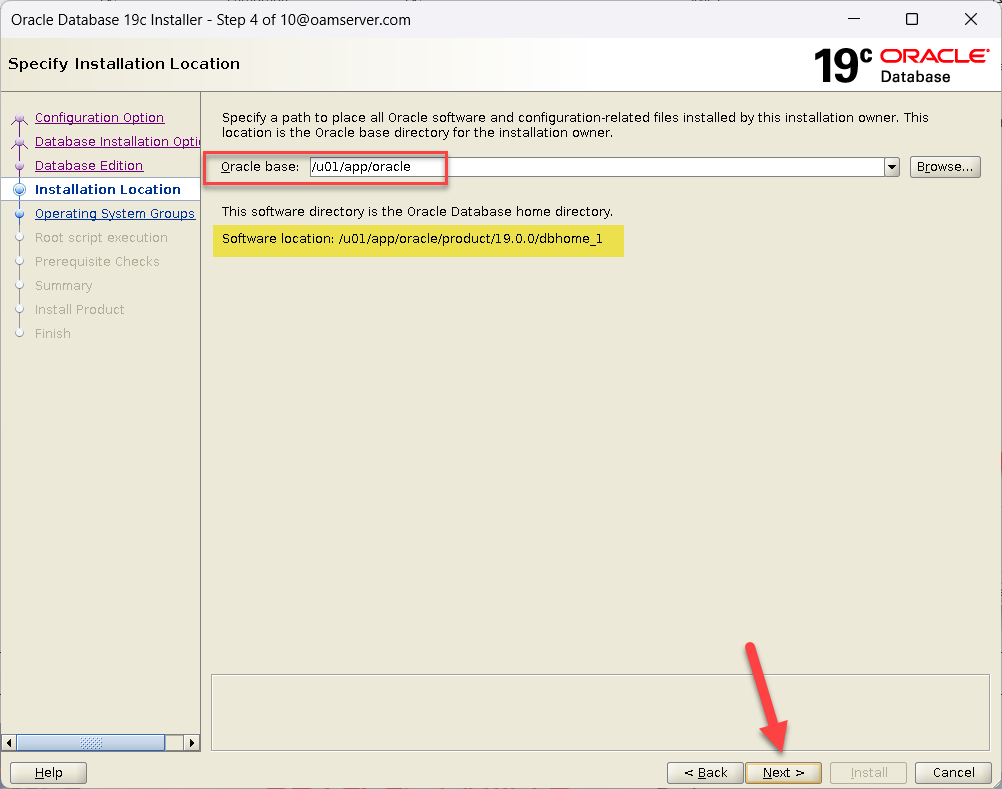 |
| Select Database Administration Groups
Click Next |
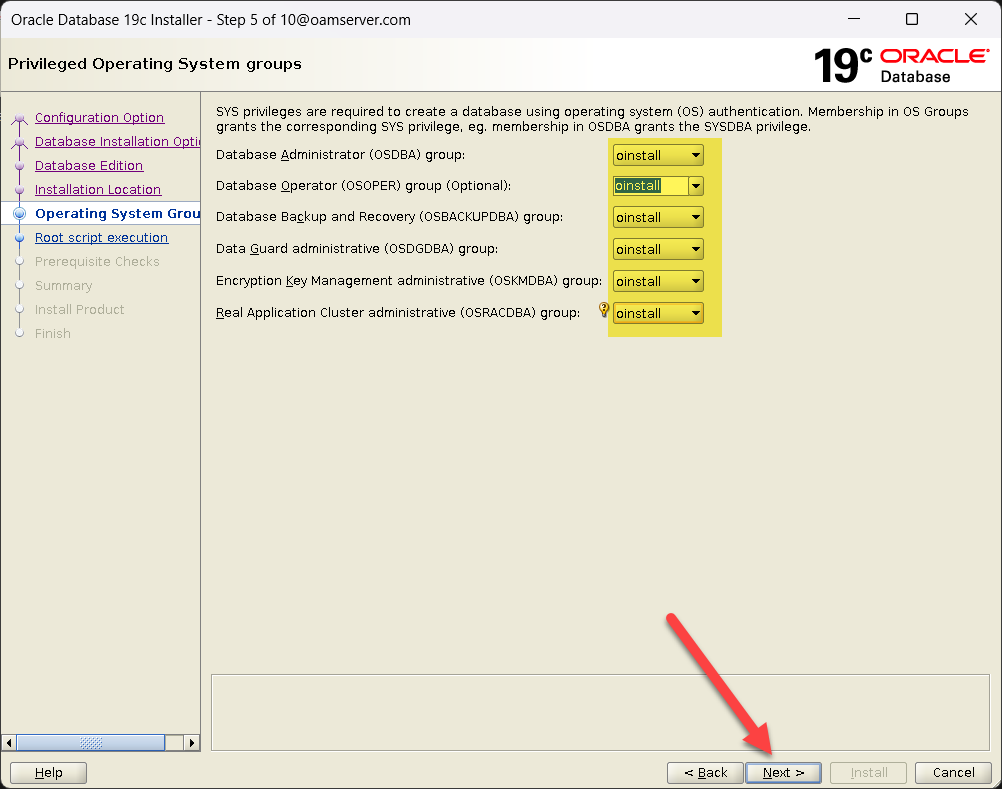 |
| Click Next | 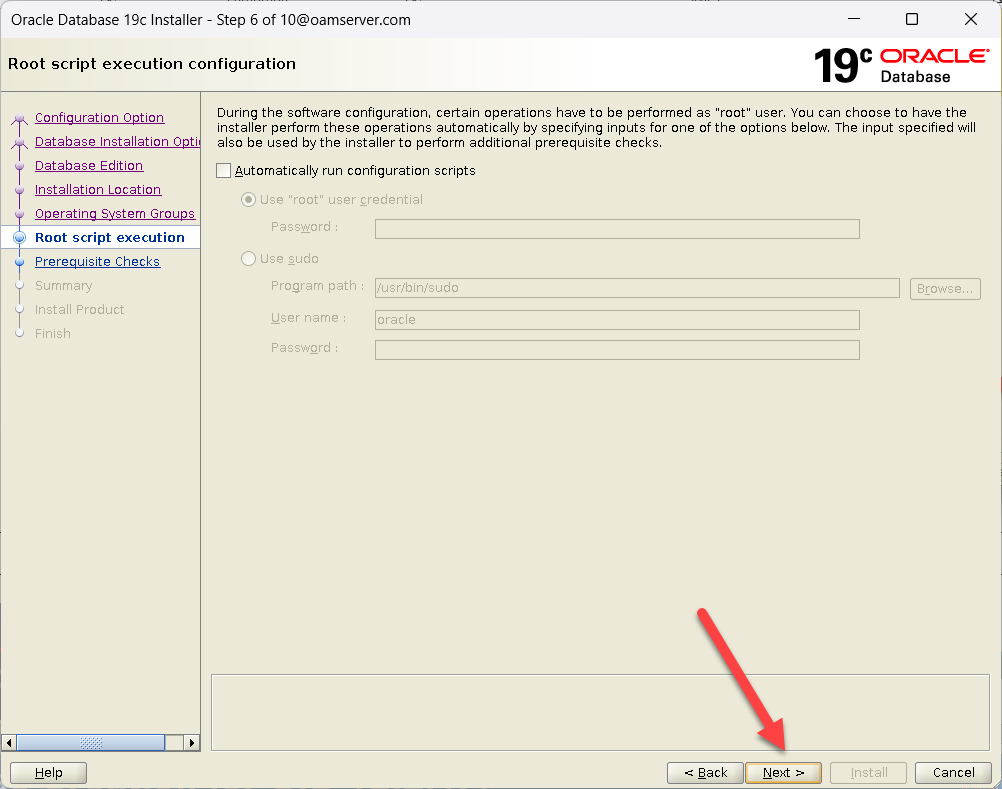 |
| Click Install | 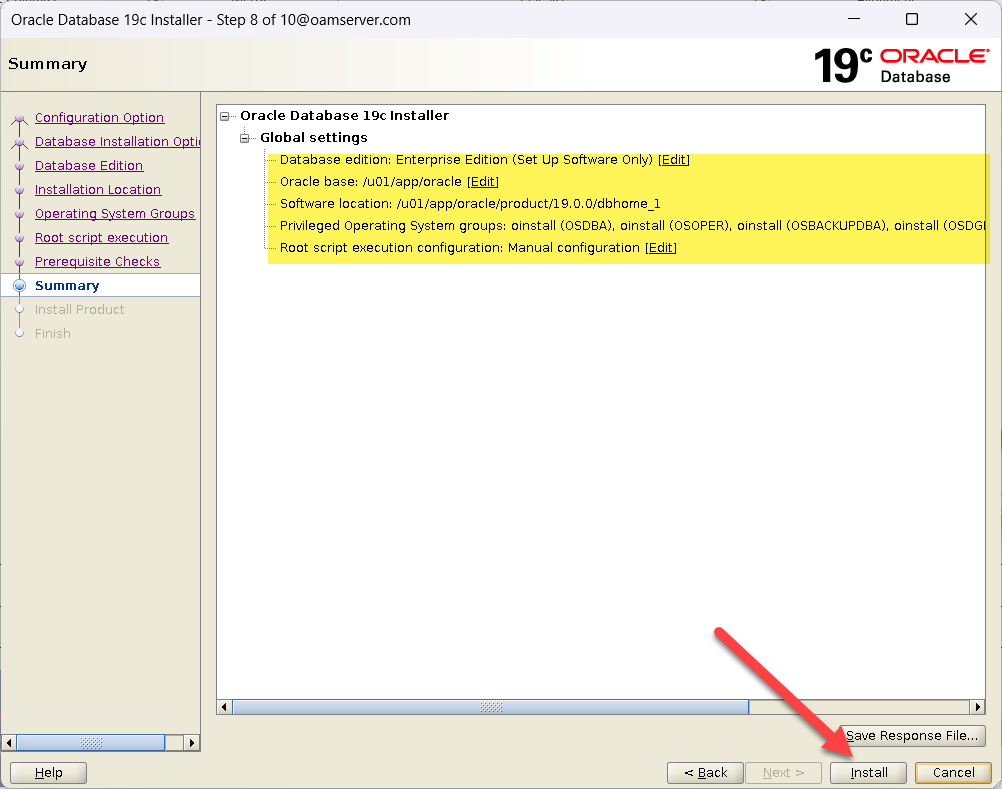 |
| Installation Started | 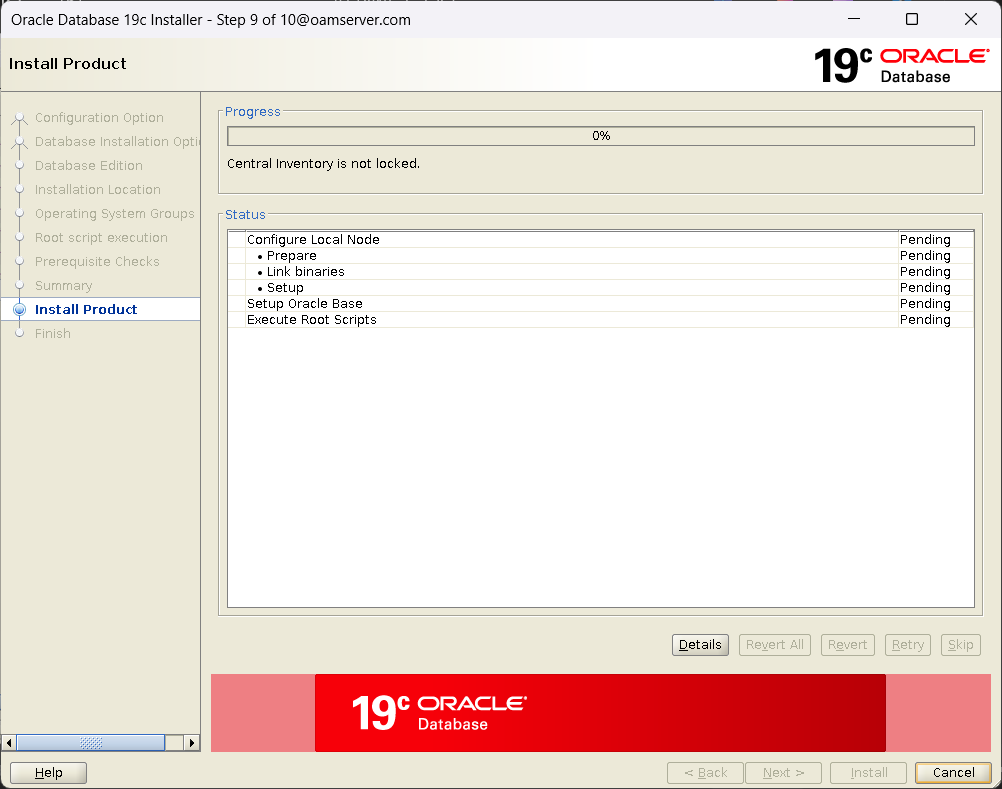 |
| Run the Script with Root User
[root@oidserver ~]# /u01/app/oracle/product/19.0.0/dbhome_1/root.sh Click OK |
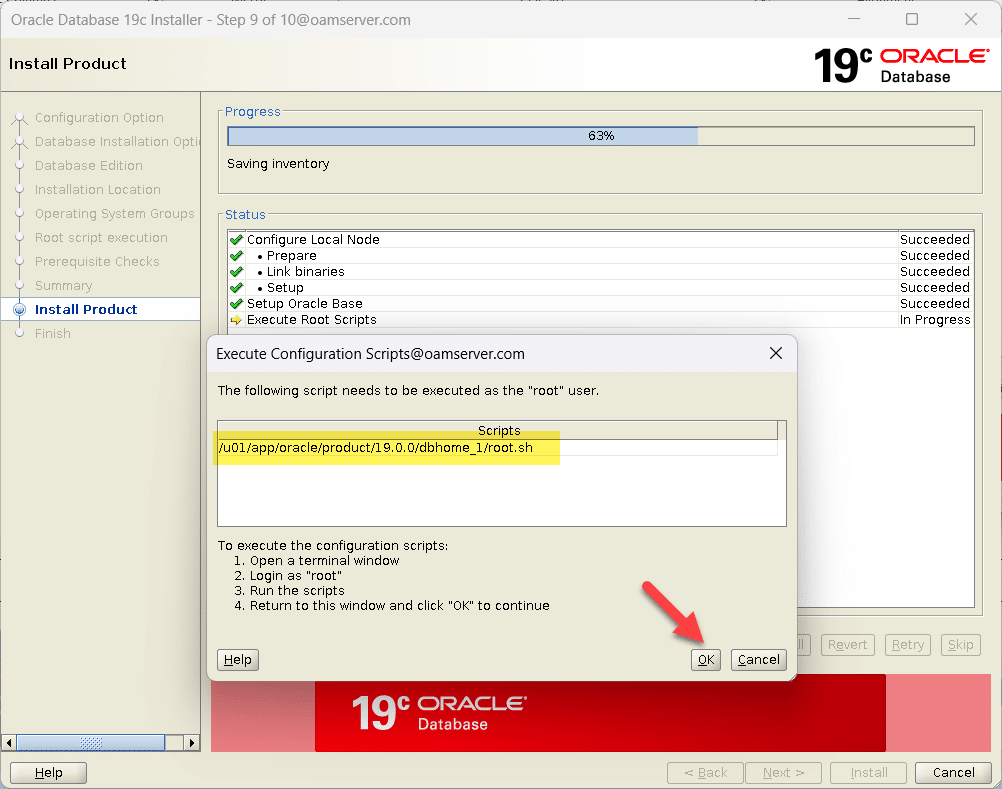 |
| Click Close | 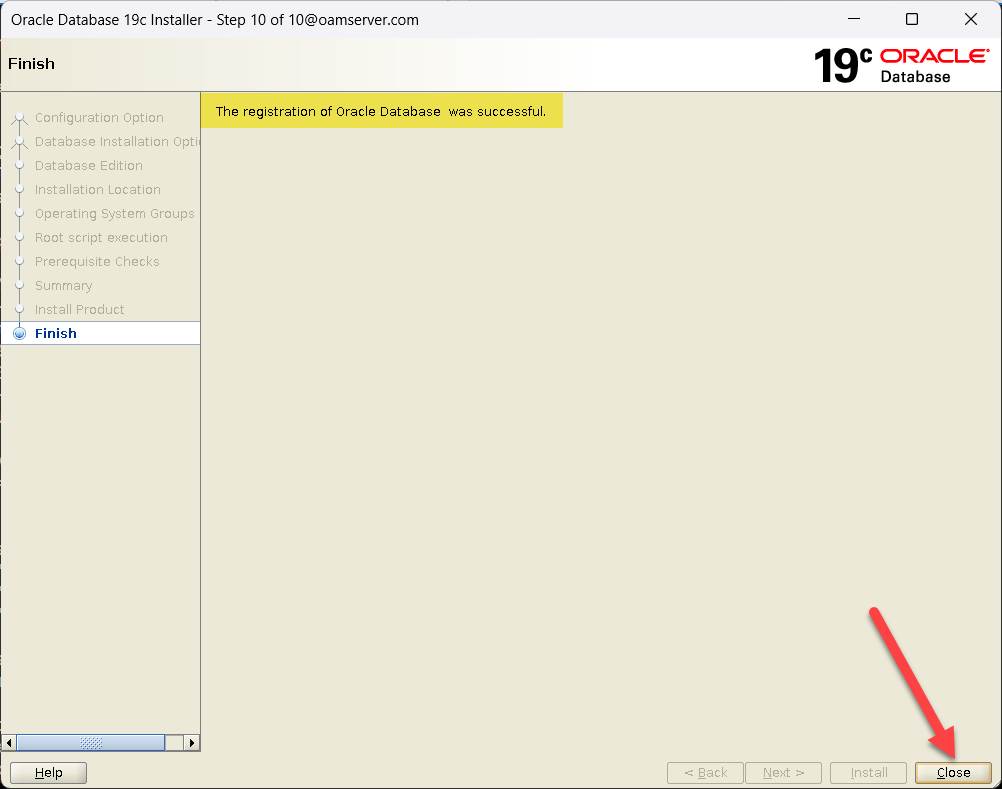 |
Database Creation through DBCA |
|
| [oracle@oamserver ~]$ . ./setEnv.sh
[oracle@oamserver ~]$ dbca |
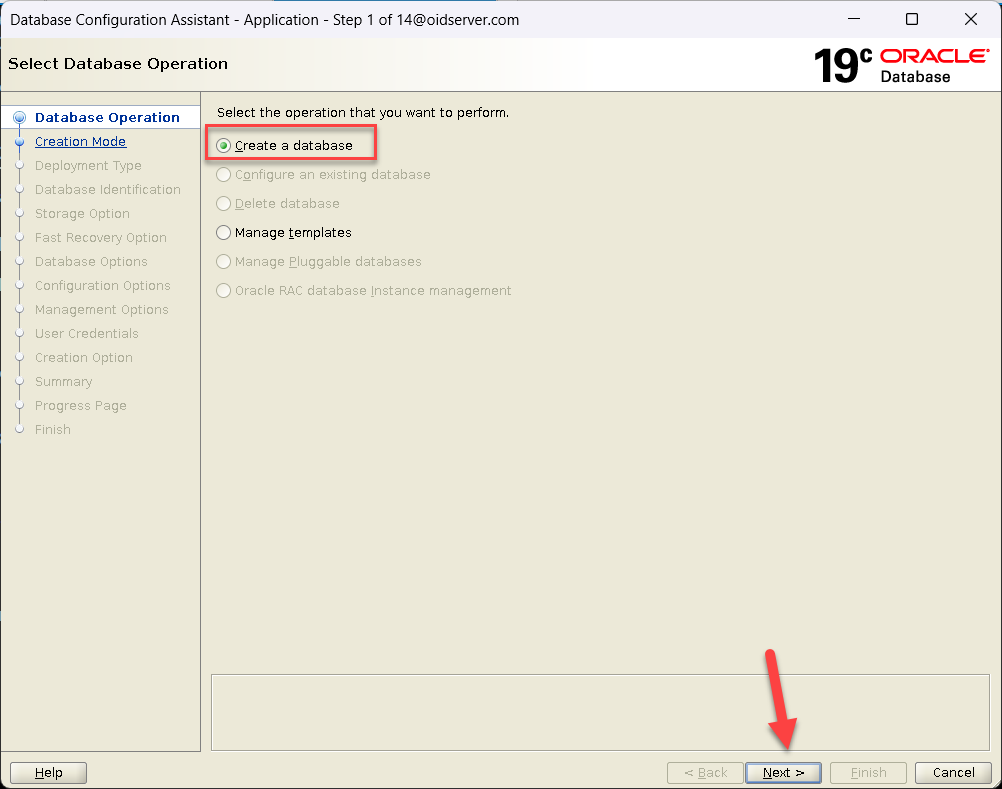 |
| Select Advanced Configuration
Click Next |
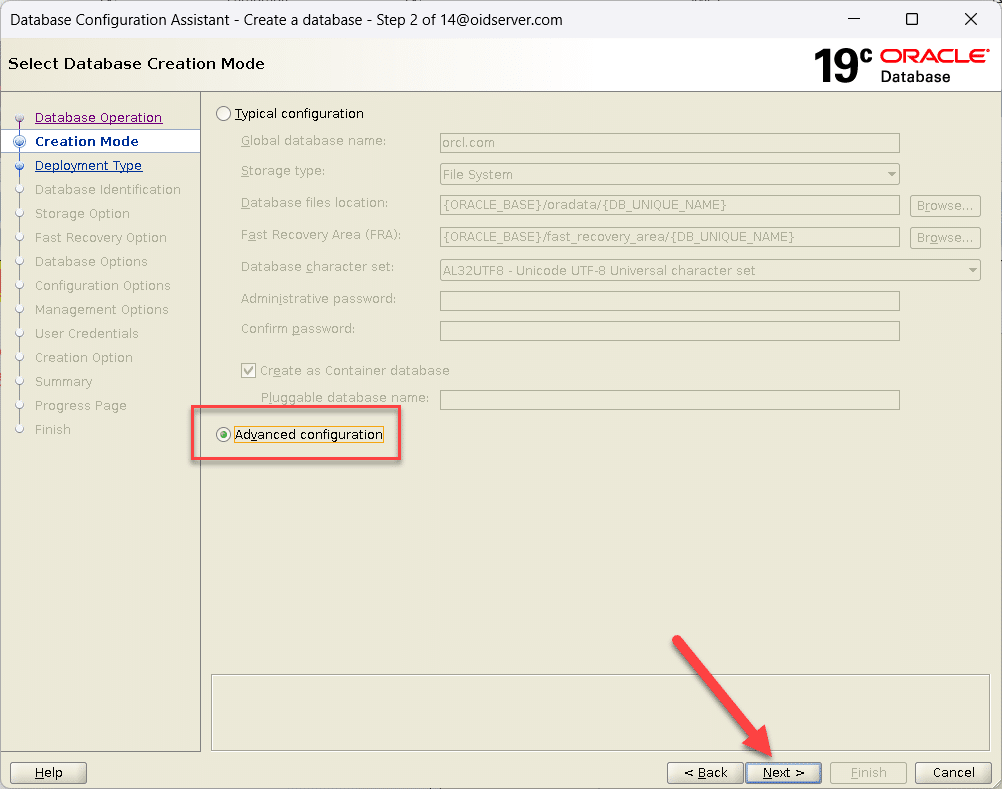 |
| Select Oracle Single Instance database
Select Template Name General Purpose or TransactionProcessing Click Next |
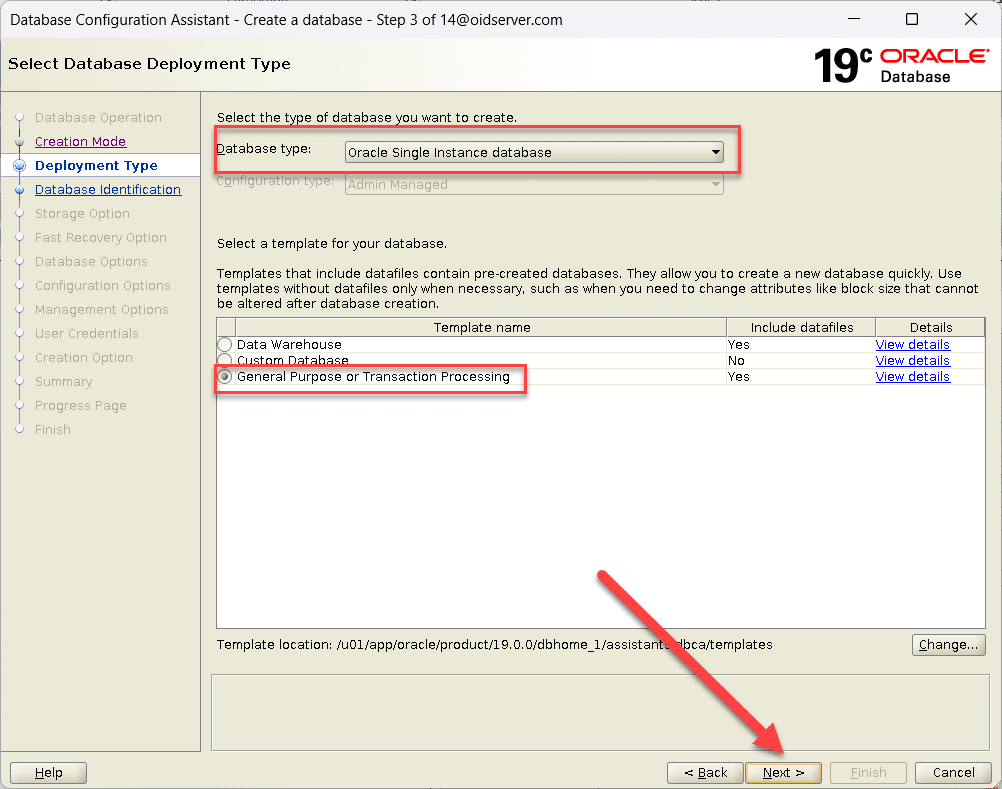 |
| Enter Global Database name and SID
Uncheck Option Create as Container database Click Next |
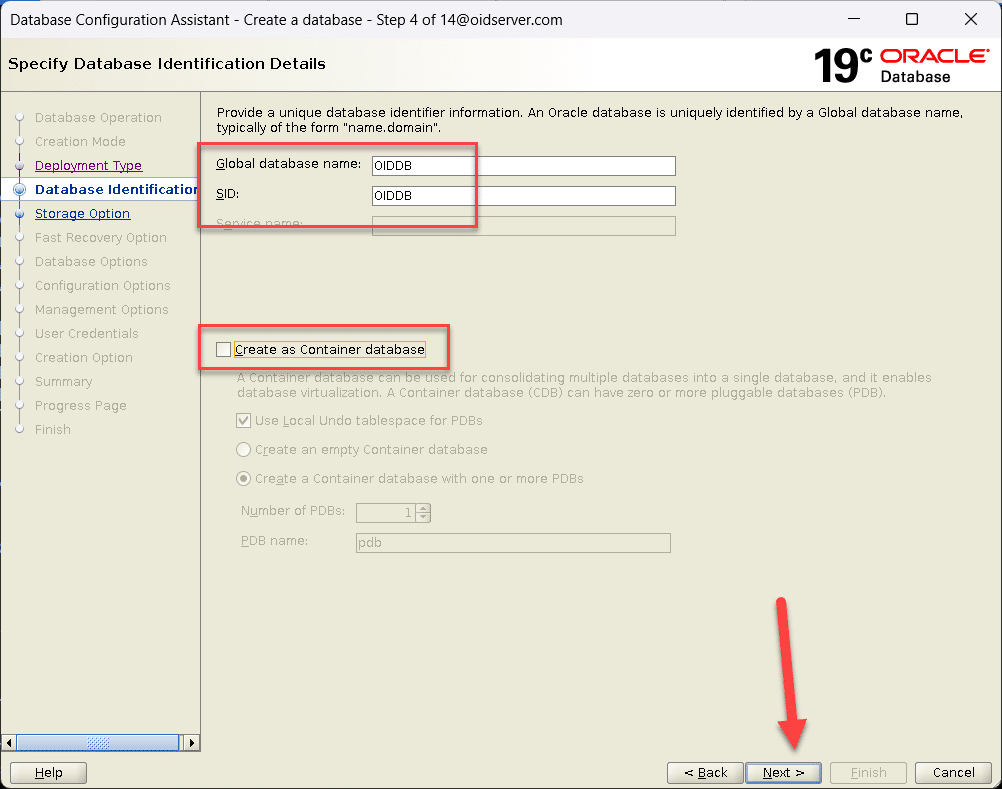 |
| Click Next | 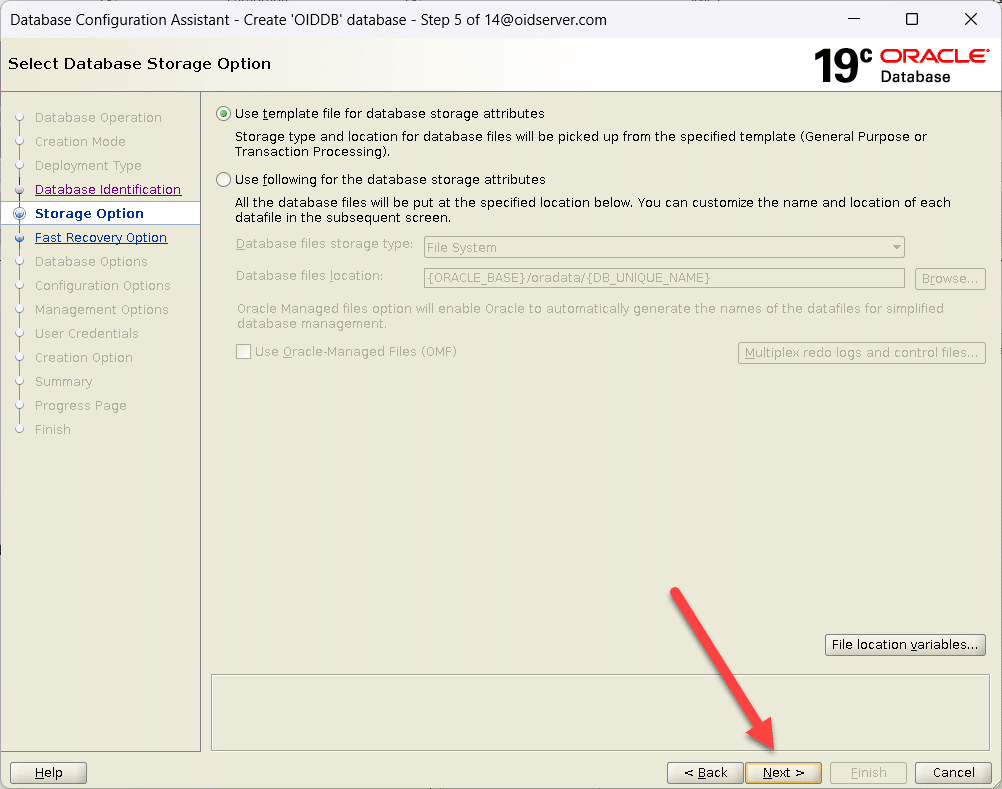 |
| Click Next | 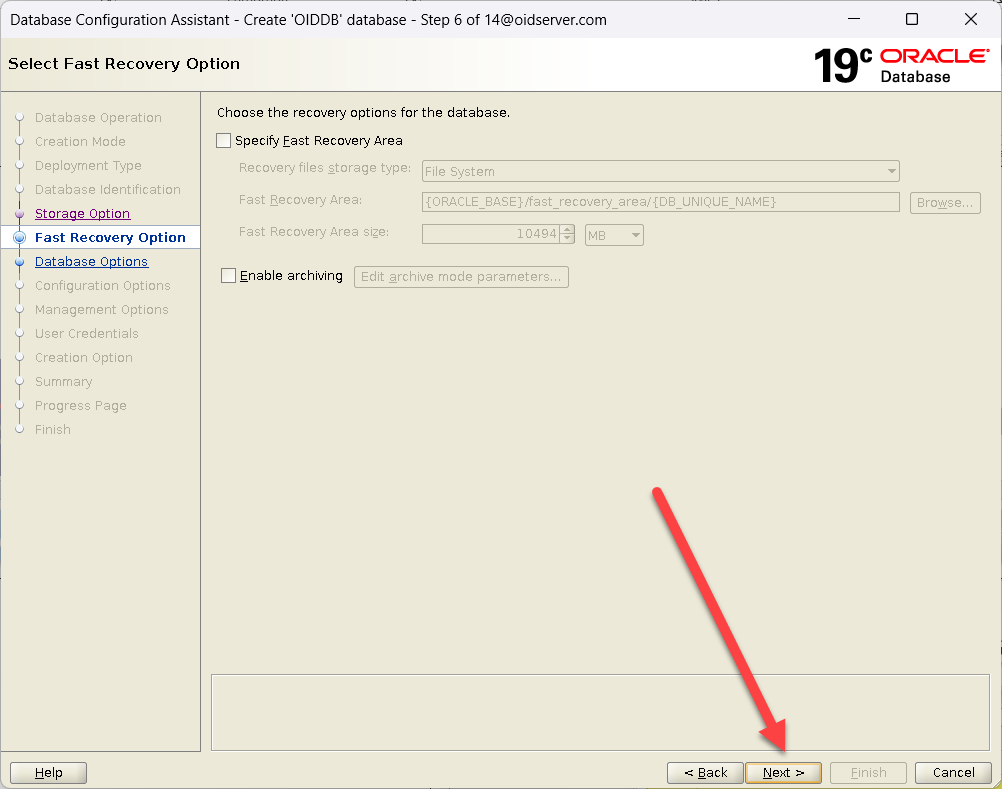 |
| Click Next | 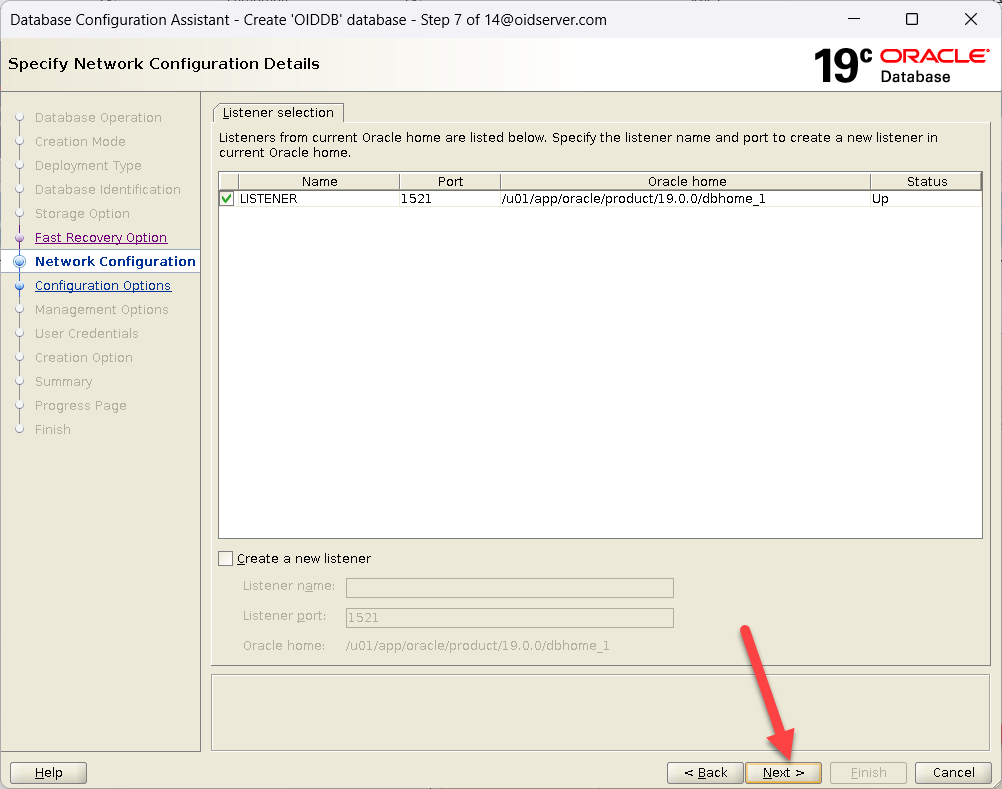 |
| Click Next | 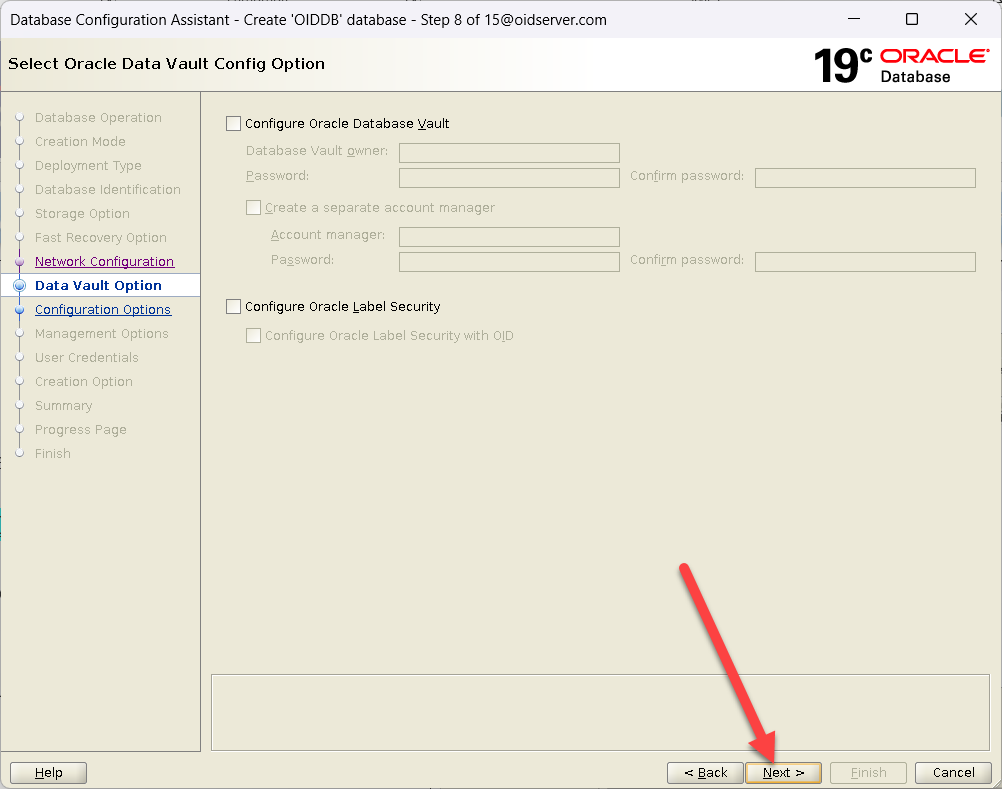 |
| Click Next | 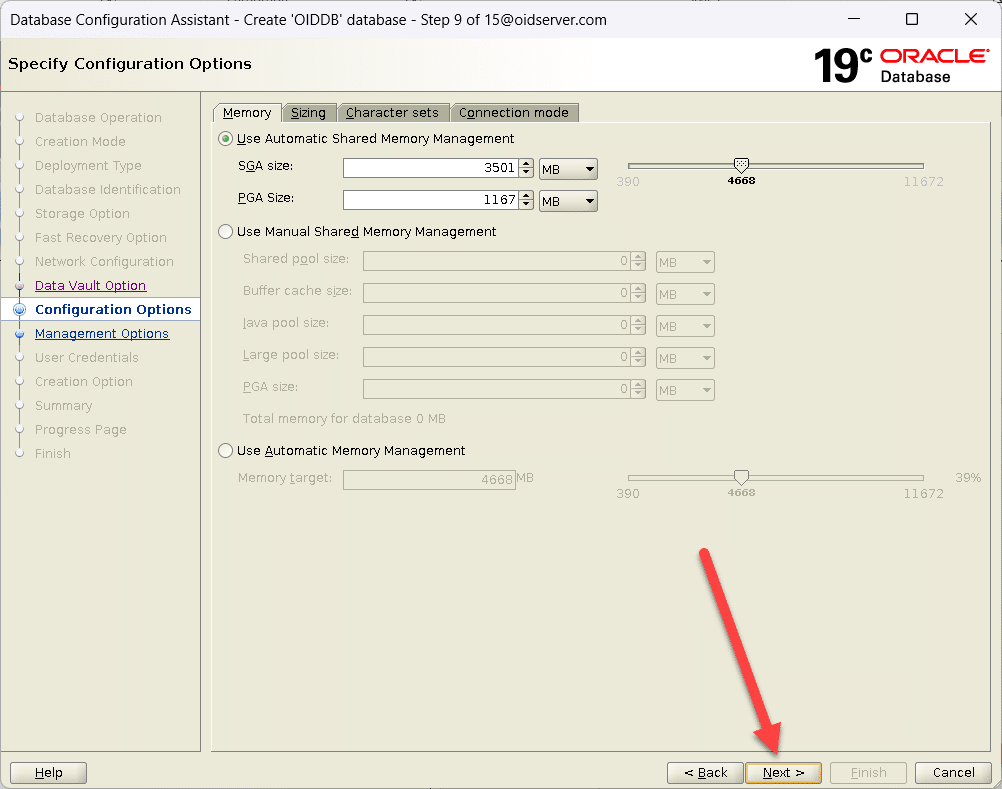 |
| Click Next | 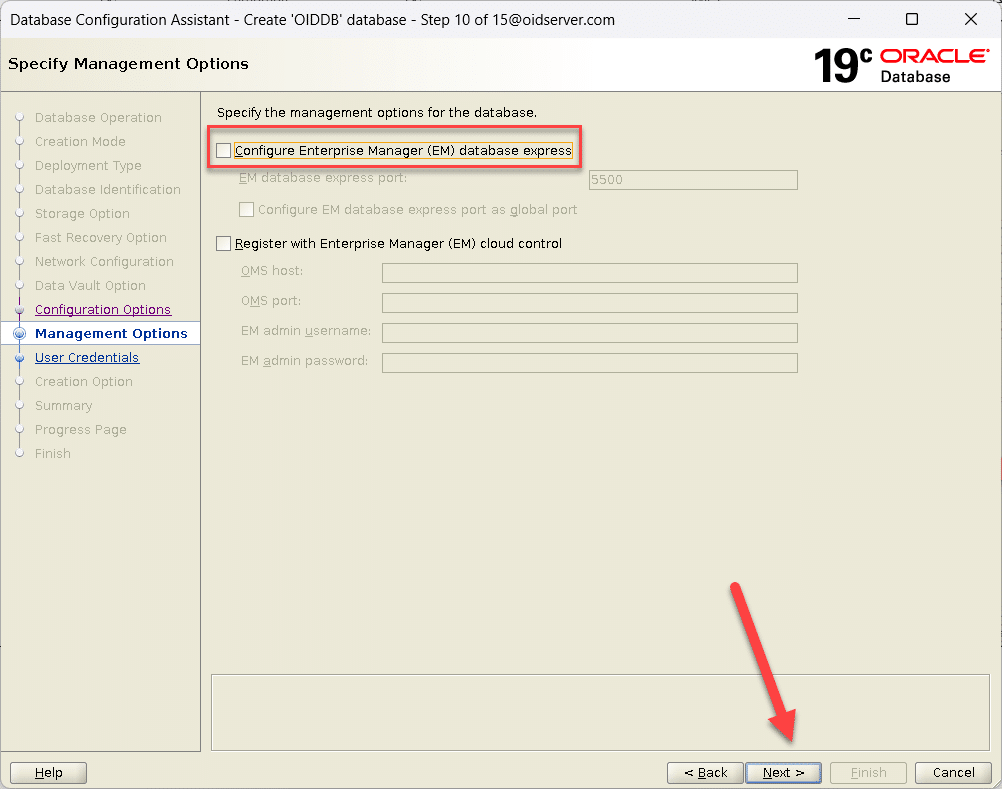 |
| We used the Same Password for all Administrative accounts.
Click Next |
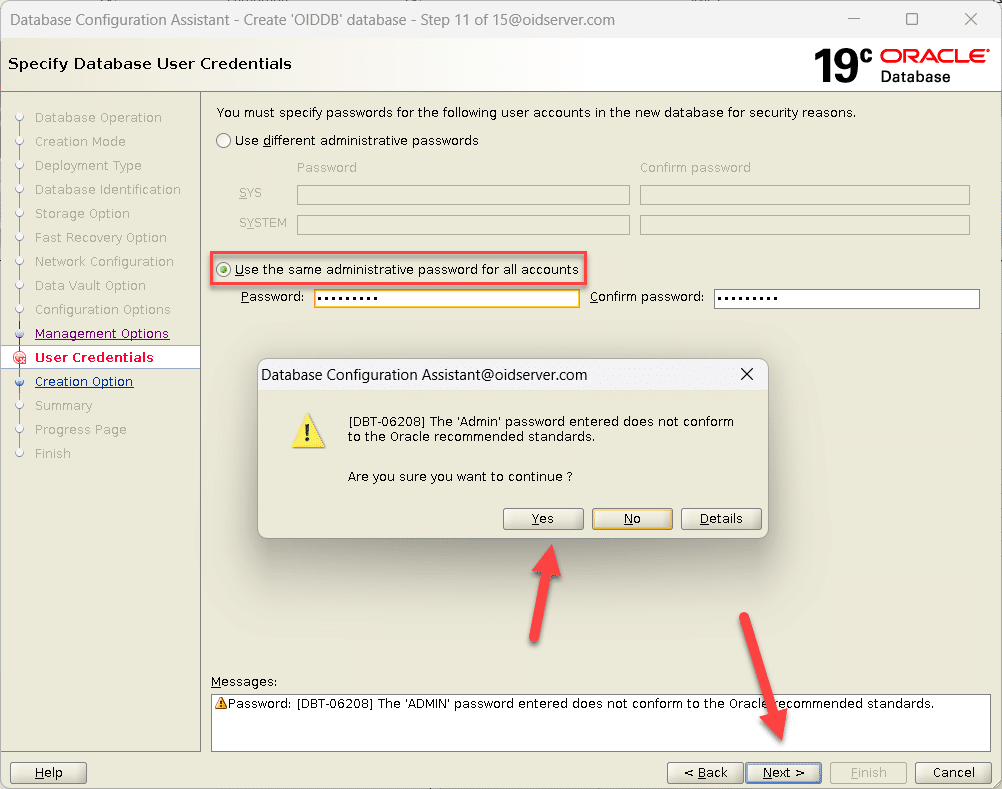 |
| Click Next | 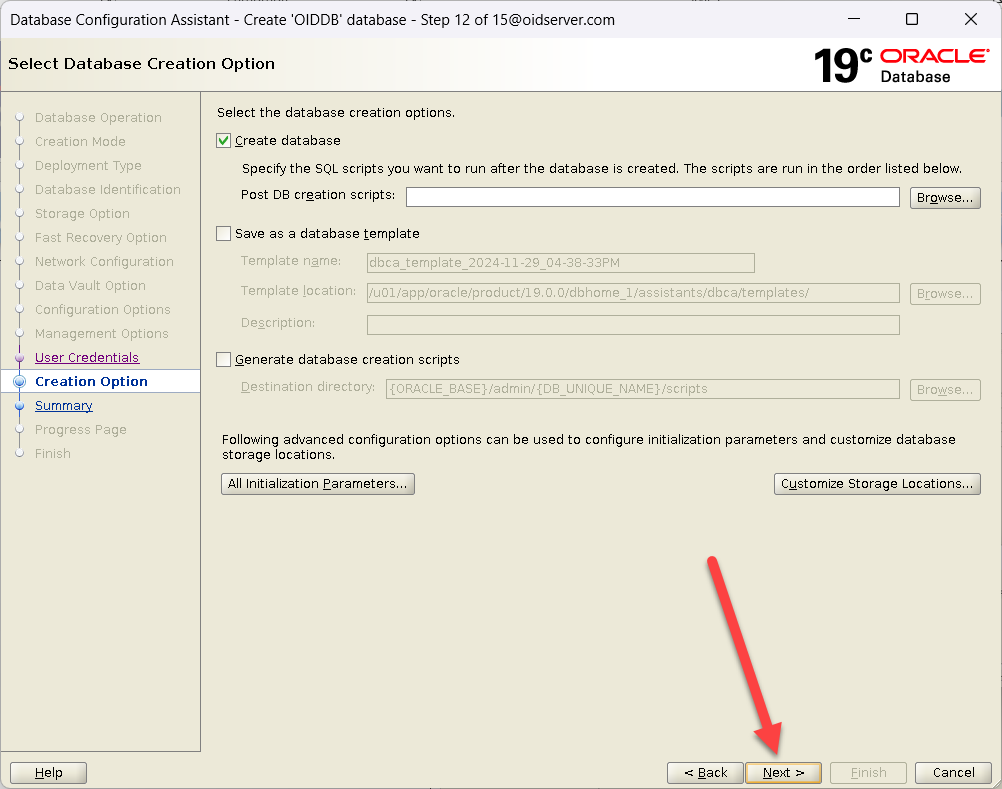 |
| Verify the settings on the Installation Summary screen.
To change entries, Click BACK to the pertinent screen. Once satisfied with the settings, click the Finish button to begin the installation. |
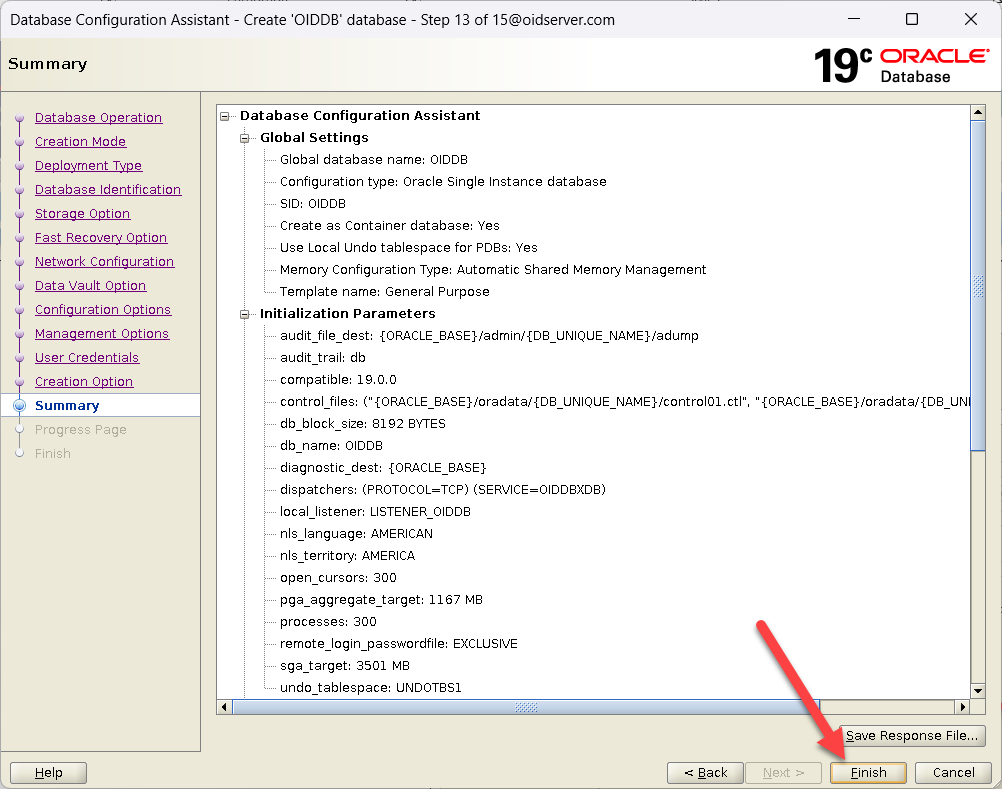 |
| Database Creation Started | 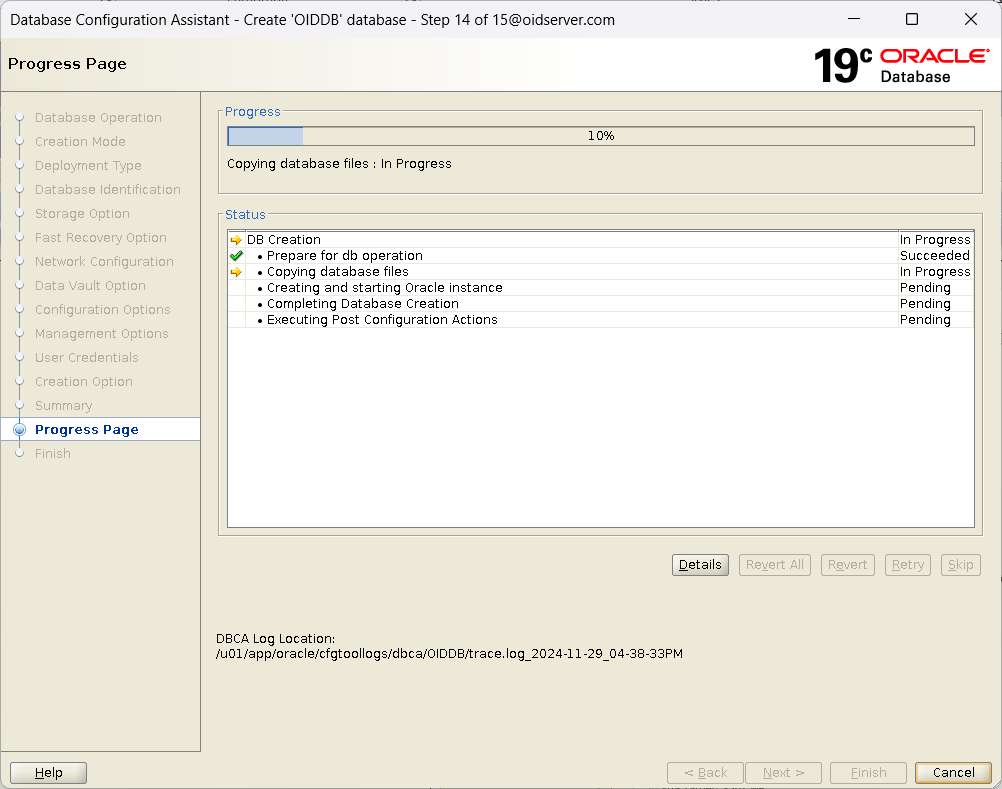 |
| Click Close | 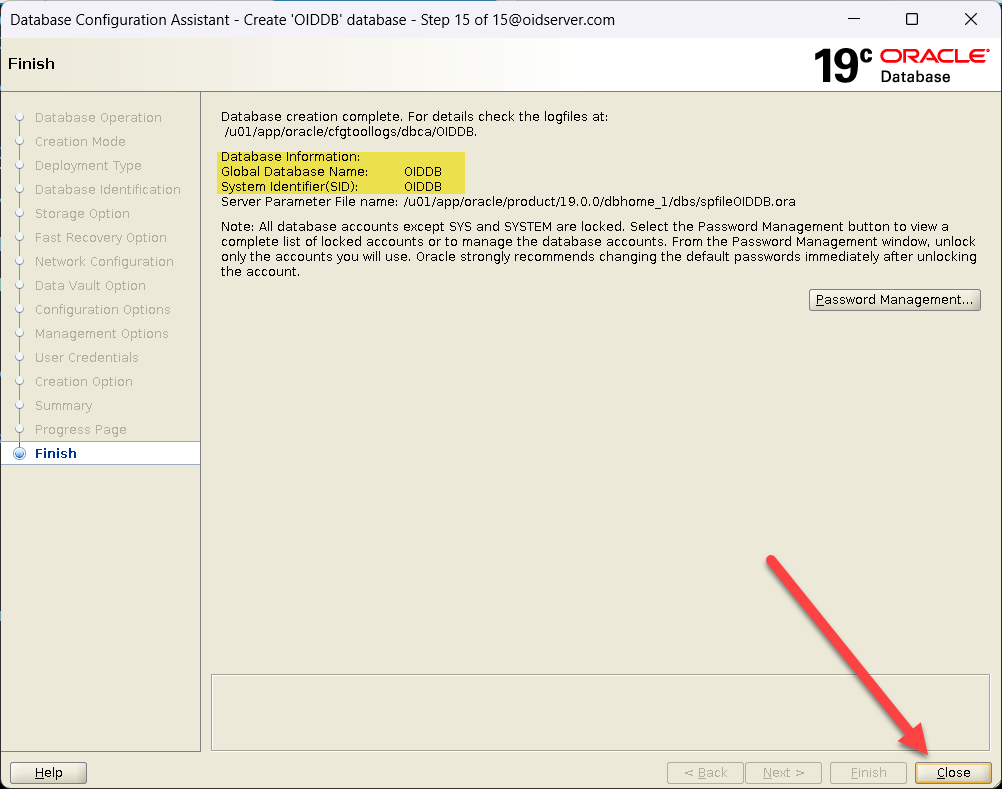 |
Alter Database Parameters |
|
| SQL> alter system set open_cursors=800 scope=both; SQL> alter system set processes=1000 scope=spfile; SQL> alter system set sessions=1000 scope=spfile; |
|
Hope you found this document informative and gained valuable insights.
Step-by-Step Guide: Installing and Configuring Oracle Internet Directory 12.2.1.4
Prerequisites and Environment Setup
Before diving into the installation process, ensure that your environment meets the necessary prerequisites.
Environment Resources
Below is a summary of the resources used in this setup:
Hardware Resources |
|
|---|---|
| Component | Details |
| Virtualization | VirtualBox |
| RAM | 10 GB |
| Hard Drive | 100 GB |
| CPU | 4 vCPU |
Software Resources |
|
|---|---|
| Component | Version/Details |
| Operating System | Oracle Enterprise Linux 8.10 |
| Oracle Database | Oracle Database 19c |
| Fusion Middleware (FMW) | 12.2.1.4 |
| Oracle Internet Directory | 12.2.1.4 |
Action Plan for The Installation:
The installation process will be divided into the following parts, as illustrated below. Each part will be thoroughly explored and discussed in detail as presented below.
Step 1: Install Oracle Database 19c
Oracle Internet Directory requires a backend database to store its metadata. Oracle Database 19c is a recommended choice.
Key Steps:
- Download and install the Oracle Database software.
- Create a database instance to host the OID schema.
- Ensure the database is running before proceeding to subsequent steps.
For detailed instructions, refer to Oracle Database 19c Installation for OID.
Step 2: Install Fusion Middleware 12.2.1.4
Oracle Fusion Middleware is required for the OID installation.
Key Steps:
- Download the Fusion Middleware Infrastructure 12.2.1.4 installer.
- Use the Oracle Universal Installer (OUI) to install the software.
- Validate the installation with the rcu utility.
For details, visit FMW 12.2.1.4 Installation for Oracle Internet Directory(OID).
Step 3: Install Oracle Internet Directory
Once Fusion Middleware is installed, the next step is to install OID.
Key Steps:
- Use the Oracle Universal Installer to install the OID binaries.
- Ensure the proper directory structure is created.
Refer to Oracle Internet Directory 12.2.1.4 Installation for detailed steps.
Step 4: Configure WebLogic Domain for OID
The Oracle WebLogic Server domain is a crucial component that manages OID services.
Key Steps:
- Create a new WebLogic domain for OID.
- Configure the domain using the WebLogic Configuration Wizard.
- Start the WebLogic Admin Server.
Detailed instructions are available in Configure Weblogic Domain for OID 12.2.1.4.
Step 5: Configure Oracle Internet Directory
The final step is to configure and initialize OID.
Key Steps:
- Test and verify the configuration using OID tools.
- Integrate with external applications as required.
Follow Configure Oracle Internet Directory(OID) 12.2.1.4 for the full guide.
Final Verification and Testing
After completing the above steps, perform the following checks to ensure the installation and configuration are successful:
- Verify that all services (OID and WebLogic) are up and running.
- Use ldapbind and ldapsearch commands to test the OID service.
- Check the WebLogic Admin Console for server health.
Conclusion
Installing and configuring Oracle Internet Directory 12.2.1.4 involves multiple interconnected steps. Following this comprehensive guide can streamline the process and ensure a successful deployment. For additional details on each task, refer to the linked individual posts.
If you encounter any issues or have further questions, feel free to contact on Below: Linkedin 🔗 SyedSaadAli
Step By Step Upgrading Oracle EBS to R12.2.14
This post will offer comprehensive guidance on upgrading Oracle EBS Release R12.2.x to R12.2.14.
Step 1: Upgrade Oracle Database |
This Part covers the upgrade process of Oracle Apps R12.2.x Database from 12c to 19c, followed by a verification process to ensure a successful upgrade. if you are currently on that database version or earlier, you should now upgrade to Oracle Database 19c before proceeding with next steps. To upgrade your database, follow the process documented in Interoperability Notes: Oracle E-Business Suite Release 12.2 with Oracle Database 19c, My Oracle Support Knowledge Document 2552181.1 Use the Following Links below if you want to Upgrade the Database to 19c Important Notes on Upgrading to Oracle Database 19c:
Database Upgrade Part 1 Link: Oracle EBS Database Upgrade from 12c to 19c Part-1Database Upgrade Part 2 Link: Oracle EBS Database Upgrade from 12c to 19c Part-2 |
Step 2: Apply Latest AD and TXK Delta Release Update Packs |
| A) (ETCC) EBS Technology Codelevel Checker Use the Below given link to Download the latest ETCC Patch and Identifying and applying the required Database and Middleware Technology Patches Link Apply ETCC(OCT-2024) Patches B) Oracle Official Document for AD-TXK Applying the Latest AD and TXK Release Update Packs to Oracle E-Business Suite Release 12.2 (Doc ID 1617461.1) Applying the Latest AD and TXK Release Update Packs to Oracle E-Business Suite Release 12.2, and follow the instructions to apply the required codelevel of AD and TXK for your system. The Oracle E-Business Suite Applications DBA and Technology Stack release update packs R12.AD.C.Delta.16 and R12.TXK.C.Delta.16 include a set of structural changes that modernize the EBS database architecture, including a schema named EBS_SYSTEM. C) Link to Apply AD-TXK Link Apply AD TXK 16 |
Step 3 Apply Oracle E-Business Suite 12.2.14 Release Update Pack |
|
a) Source the run edition applications environment. |
| [oracle@ebs12214 ~]$ . ./EBSapps.env E-Business Suite Environment Information —————————————- RUN File System : /u01/oracle/PROD/fs2/EBSapps/appl PATCH File System : /u01/oracle/PROD/fs1/EBSapps/appl Non-Editioned File System : /u01/oracle/PROD/fs_ne DB Host: ebs12214.com Service/SID: PROD E-Business Suite Environment Setting ———————————— – Enter [R/r] for sourcing Run File System Environment file, or – Enter [P/p] for sourcing Patch File System Environment file, or – Enter anything else to exit Please choose the environment file you wish to source [R/P]:R Sourcing the RUN File System … |
b) Unzip and Staging the Patch 36026788 |
[oracle@ebs12214 ~]$ cd /u01/Patches/12214_upgrade [oracle@ebs12214 12214_upgrade]$ unzip -o ‘*.zip’ [oracle@ebs12214 12214_upgrade]$ cp -pr 36026788 $PATCH_TOP |
c) Start an Online Patching Cycle |
| [oracle@ebs12214 ~]$ adop phase=prepare Enter the APPS password: Enter the EBS_SYSTEM password: Enter the WLSADMIN password: Validating credentials. Warning: WebLogic Admin Server is not running. Trying to start Admin Server. You are running adadminsrvctl.sh version 120.10.12020000.11 Starting WLS Admin Server… Refer /u01/oracle/PROD/fs2/inst/apps/PROD_ebs12214/logs/appl/admin/log/adadminsrvctl.txt for details AdminServer logs are located at /u01/oracle/PROD/fs2/FMW_Home/user_projects/domains/EBS_domain/servers/AdminServer/logs adadminsrvctl.sh: exiting with status 0 adadminsrvctl.sh: check the logfile /u01/oracle/PROD/fs2/inst/apps/PROD_ebs12214/logs/appl/admin/log/adadminsrvctl.txt for more information … Initializing. Run Edition context : /u01/oracle/PROD/fs2/inst/apps/PROD_ebs12214/appl/admin/PROD_ebs12214.xml Patch edition context: /u01/oracle/PROD/fs1/inst/apps/PROD_ebs12214/appl/admin/PROD_ebs12214.xml Patch file system free space: 149.84 GB Validating system setup. Node registry is valid. Checking for existing adop sessions. No pending session exists. Starting new adop session. =========================================================================== ADOP (C.Delta.16) Session ID: 15 Node: ebs12214 Phase: prepare Log: /u01/oracle/PROD/fs_ne/EBSapps/log/adop/15/20241209_200033/adop.log =========================================================================== Validating configuration on node: [ebs12214]. Verifying data dictionary. Validating system is ready to prepare. Log: /u01/oracle/PROD/fs_ne/EBSapps/log/adop/15/20241209_200033/prepare/ebs12214 Detecting configuration changes. Log: /u01/oracle/PROD/fs_ne/EBSapps/log/adop/15/20241209_200033/prepare/ebs12214/adConfigChanges.log The log file is /u01/oracle/PROD/fs_ne/EBSapps/log/adop/15/20241209_200033/prepare/ebs12214/adConfigChanges.log Configuration change detected. File system configuration changes were detected. Checking AD-TXK codelevel. AD-TXK codelevel has not changed. Checking for pending cleanup actions. Running cleanup as it was not run in previous patching cycle. Processing cleanup actions in parallel. Log: /u01/oracle/PROD/fs_ne/EBSapps/log/adop/15/20241209_200033/prepare/ebs12214/log/cleanup.log Generating report of queued DDL actions. Output: /u01/oracle/PROD/fs_ne/EBSapps/log/adop/15/20241209_200033/prepare/ebs12214/adzdallddls.out Running cleanup in STANDARD mode. Log: @ADZDSHOWLOG.sql “2024/12/09 20:06:39” [ERROR] [CLEANUP 1:1 ddl_id=26909] ORA-01432: public synonym to be dropped does not exist SQL: drop public synonym WF_ALL_JOBS force Validating database is ready to prepare. Starting Apps listener. adalnctl.sh version 120.3.12020000.4 Checking for FNDFS executable. Starting listener process APPS_PROD. adalnctl.sh: exiting with status 0 adalnctl.sh: check the logfile /u01/oracle/PROD/fs2/inst/apps/PROD_ebs12214/logs/appl/admin/log/adalnctl.txt for more information … Submitting ADZDPATCH concurrent program. Saving database logs from previous session. Output: /u01/oracle/PROD/fs_ne/EBSapps/log/adop/15/20241209_200033/prepare/ebs12214/adzdshowlog_cleanup.out Creating database patch edition. Log: @ADZDSHOWLOG.sql “2024/12/09 20:06:47” preparing the seed tables needed for autoconfig execution. Synchronizing patch filesystem with run filesystem. Log: /u01/oracle/PROD/fs_ne/EBSapps/log/adop/15/20241209_200033/prepare/ebs12214 Stopping node manager. You are running adnodemgrctl.sh version 120.11.12020000.12The Node Manager is already shutdown NodeManager log is located at /u01/oracle/PROD/fs1/FMW_Home/wlserver_10.3/common/nodemanager/nmHome1 adnodemgrctl.sh: exiting with status 2 The prepare phase completed successfully. adop exiting with status = 0 (Success)
|
d) Apply Oracle E-Business Suite Release 12.2.14 Patch 36026788. |
| [oracle@ebs12214 ~]$ adop phase=apply patches=36026788 wait_on_failed_job=yes workers=4 flags=autoskip Enter the APPS password: Enter the EBS_SYSTEM password: Enter the WLSADMIN password: Validating credentials. Initializing. Run Edition context : /u01/oracle/PROD/fs2/inst/apps/PROD_ebs12214/appl/admin/PROD_ebs12214.xml Patch edition context: /u01/oracle/PROD/fs1/inst/apps/PROD_ebs12214/appl/admin/PROD_ebs12214.xml Patch file system free space: 129.40 GB Validating system setup. Patch file system free space: 129.40 GB Validating system setup. Node registry is valid. Checking for existing adop sessions. Continuing with existing session [Session ID: 15]. =========================================================================== ADOP (C.Delta.16) Session ID: 15 Node: ebs12214 Phase: apply Log: /u01/oracle/PROD/fs_ne/EBSapps/log/adop/15/20241209_205240/adop.log =========================================================================== Applying patch 36026788. Log: /u01/oracle/PROD/fs_ne/EBSapps/log/adop/15/20241209_205240/apply/ebs12214/36026788/log/u36026788.log [WARNING] Some patching actions failed and were skipped [WARNING] Refer to the autoskip logfile for the list of skipped jobs [WARNING] Logfile: /u01/oracle/PROD/fs_ne/EBSapps/log/adop/15/20241209_205240/apply/ebs12214/36026788/log/autoskip.log Generating post apply reports. Generating log report. Output: /u01/oracle/PROD/fs_ne/EBSapps/log/adop/15/20241209_205240/apply/ebs12214/adzdshowlog.out The apply phase completed successfully. adop exiting with status = 0 (Success) |
e) Complete the Patching Cycle (Finalize, Cutover, FSclone) |
i) Run Finalize[oracle@ebs12214 ~]$ adop phase=finalize Enter the APPS password: Enter the EBS_SYSTEM password: Enter the WLSADMIN password: Validating credentials. Initializing. Run Edition context : /u01/oracle/PROD/fs2/inst/apps/PROD_ebs12214/appl/admin/PROD_ebs12214.xml Patch edition context: /u01/oracle/PROD/fs1/inst/apps/PROD_ebs12214/appl/admin/PROD_ebs12214.xml Patch file system free space: 120.50 GB Validating system setup. Node registry is valid. Checking for existing adop sessions. Continuing with existing session [Session ID: 15]. Session Id : 15 Prepare phase status : COMPLETED Apply phase status : ATLEAST ONE PATCH IS ALREADY APPLIED Cutover phase status : NOT COMPLETED Abort phase status : NOT COMPLETED Session status : FAILED =========================================================================== ADOP (C.Delta.16) Session ID: 15 Node: ebs12214 Phase: finalize Log: /u01/oracle/PROD/fs_ne/EBSapps/log/adop/15/20241210_033617/adop.log =========================================================================== Verifying data dictionary. Running finalize phase database actions. Log: @ADZDSHOWLOG.sql “2024/12/10 03:36:57” Generating log report. Output: /u01/oracle/PROD/fs_ne/EBSapps/log/adop/15/20241210_033617/finalize/ebs12214/adzdshowlog.out The finalize phase completed successfully. adop exiting with status = 0 (Success) [oracle@ebs12214 ~]$ ii) Run Cutover[oracle@ebs12214 ~]$ adop phase=cutover Enter the APPS password: Enter the EBS_SYSTEM password: Enter the WLSADMIN password: Validating credentials. Initializing. Run Edition context : /u01/oracle/PROD/fs2/inst/apps/PROD_ebs12214/appl/admin/PROD_ebs12214.xml Patch edition context: /u01/oracle/PROD/fs1/inst/apps/PROD_ebs12214/appl/admin/PROD_ebs12214.xml Patch file system free space: 120.47 GB Validating system setup. Node registry is valid. Checking for existing adop sessions. Continuing with existing session [Session ID: 15]. =========================================================================== ADOP (C.Delta.16) Session ID: 15 Node: ebs12214 Phase: cutover Log: /u01/oracle/PROD/fs_ne/EBSapps/log/adop/15/20241210_034304/adop.log =========================================================================== Validating configuration on node: [ebs12214]. Log: /u01/oracle/PROD/fs_ne/EBSapps/log/adop/15/20241210_034304/cutover/validate/ebs12214 Checking if finalize required. Finalize phase is not required Submitting request for Internal Concurrent Manager shutdown. You are running adcmctl.sh version 120.19.12020000.7 Shutting down concurrent managers for PROD … ORACLE Password: Submitted request 512325 for CONCURRENT FND SHUTDOWN adcmctl.sh: exiting with status 0 ============================== ************************* ============================================= Calling /u01/oracle/PROD/fs1/EBSapps/comn/util/jdk32/jre/bin/java … Flipping snapshots in run and patch editions. Performing file system cutover. Checking if file system cutover completed. Starting run edition Admin Server. Starting application tier services. Waiting for middle tier services to start on all available nodes. Generating post-cutover reports. Generating log report. Output: /u01/oracle/PROD/fs_ne/EBSapps/log/adop/15/20241210_034304/cutover/ebs12214/adzdshowlog.out The cutover phase completed successfully. adop exiting with status = 0 (Success) |
iii) Open New Terminal And Source Environment |
| [oracle@ebs12214 ~]$ . ./EBSapps.env run E-Business Suite Environment Information —————————————- RUN File System : /u01/oracle/PROD/fs1/EBSapps/appl PATCH File System : /u01/oracle/PROD/fs2/EBSapps/appl Non-Editioned File System : /u01/oracle/PROD/fs_ne DB Host: ebs12214.com Service/SID: PROD Sourcing the RUN File System …
|
iv) Run FS Clone to Synchronized File System |
| [oracle@ebs12214 ~]$ adop phase=fs_clone Enter the APPS password: Enter the EBS_SYSTEM password: Enter the WLSADMIN password: Validating credentials. Warning: WebLogic Admin Server is not running. Trying to start Admin Server. You are running adadminsrvctl.sh version 120.10.12020000.11 Starting WLS Admin Server… Refer /u01/oracle/PROD/fs1/inst/apps/PROD_ebs12214/logs/appl/admin/log/adadminsrvctl.txt for details AdminServer logs are located at /u01/oracle/PROD/fs1/FMW_Home/user_projects/domains/EBS_domain/servers/AdminServer/logs adadminsrvctl.sh: exiting with status 0 adadminsrvctl.sh: check the logfile /u01/oracle/PROD/fs1/inst/apps/PROD_ebs12214/logs/appl/admin/log/adadminsrvctl.txt for more information … Initializing. Run Edition context : /u01/oracle/PROD/fs1/inst/apps/PROD_ebs12214/appl/admin/PROD_ebs12214.xml Patch edition context: /u01/oracle/PROD/fs2/inst/apps/PROD_ebs12214/appl/admin/PROD_ebs12214.xml Patch file system free space: 120.04 GB Validating system setup. Node registry is valid. Checking for existing adop sessions. No pending session exists. Starting new adop session. =========================================================================== ADOP (C.Delta.16) Session ID: 16 Node: ebs12214 Phase: fs_clone Log: /u01/oracle/PROD/fs_ne/EBSapps/log/adop/16/20241210_140253/adop.log =========================================================================== ======================= ********************** ========================= Stopping node manager. You are running adnodemgrctl.sh version 120.11.12020000.12 The Node Manager is already shutdown NodeManager log is located at /u01/oracle/PROD/fs2/FMW_Home/wlserver_10.3/common/nodemanager/nmHome1 adnodemgrctl.sh: exiting with status 2 adnodemgrctl.sh: check the logfile /u01/oracle/PROD/fs2/inst/apps/PROD_ebs12214/logs/appl/admin/log/adnodemgrctl.txt for more information … Generating log report. Output: /u01/oracle/PROD/fs_ne/EBSapps/log/adop/16/20241210_140253/fs_clone/ebs12214/adzdshowlog.out The fs_clone phase completed successfully. adop exiting with status = 0 (Success) [oracle@ebs12214 ~]$
|
Step 4 Post Upgrade Steps |
i) Apply Oracle E-Business Suite Release 12.2.14 Online HelpUsing adop hotpatch mode on the run file system, apply Oracle E-Business Suite Release 12.2.14 Online Help Patch 36026775. |
| Source Run Environment [oracle@ebs12214 ~]$ . ./EBSapps.env run E-Business Suite Environment Information —————————————- RUN File System : /u01/oracle/PROD/fs1/EBSapps/appl PATCH File System : /u01/oracle/PROD/fs2/EBSapps/appl Non-Editioned File System : /u01/oracle/PROD/fs_ne DB Host: ebs12214.com Service/SID: PROD Sourcing the RUN File System … Unzip Downloaded Patch [oracle@ebs12214 ~]$ cd /u01/Patches/12214_upgrade/ [oracle@ebs12214 12214_upgrade]$ unzip -qo p36026775_R12_GENERIC.zip [oracle@ebs12214 12214_upgrade]$ cp -pr 36026775/ $PATCH_TOP Apply Patch [oracle@ebs12214 ~]$ adop phase=apply patches=36026775 hotpatch=yes Enter the APPS password: Enter the EBS_SYSTEM password: Enter the WLSADMIN password: Validating credentials. Initializing. Run Edition context : /u01/oracle/PROD/fs1/inst/apps/PROD_ebs12214/appl/admin/PROD_ebs12214.xml Patch edition context: /u01/oracle/PROD/fs2/inst/apps/PROD_ebs12214/appl/admin/PROD_ebs12214.xml Patch file system free space: 119.93 GB Validating system setup. Node registry is valid. Checking for existing adop sessions. Application tier services are down. No pending session exists. Starting new adop session. =========================================================================== ADOP (C.Delta.16) Session ID: 17 Node: ebs12214 Phase: apply Log: /u01/oracle/PROD/fs_ne/EBSapps/log/adop/17/20241210_170137/adop.log =========================================================================== Applying patch 36026775. Log: /u01/oracle/PROD/fs_ne/EBSapps/log/adop/17/20241210_170137/apply/ebs12214/36026775/log/u36026775.log Running finalize actions for the patches being applied. Log: @ADZDSHOWLOG.sql “2024/12/10 17:32:36” Running cutover actions for the patches being applied. Creating workers to process cutover DDL in parallel Log: /u01/oracle/PROD/fs_ne/EBSapps/log/adop/17/20241210_170137/apply/ebs12214/log/cutover.log Loading JAR files into database. Loading JAR files into database No JAR files found to load Performing database cutover in Quick mode Generating post apply reports. Generating log report. Output: /u01/oracle/PROD/fs_ne/EBSapps/log/adop/17/20241210_170137/apply/ebs12214/adzdshowlog.out The apply phase completed successfully. adop exiting with status = 0 (Success) [oracle@ebs12214 ~]$ |
ii) Apply Oracle Application Framework PatchAfter you have installed the Oracle E-Business Suite 12.2.14 Release Update Pack, Oracle recommends that you apply the following critical patch as mentioned in Oracle E-Business Suite Release 12.2 Upgrade Considerations for OAF-based Applications and Oracle CRM Technology Foundation (Doc ID 1927975.1) OAF: Patch 36470037:R12.FWK.C Oracle Application Framework (FWK) Release Post-12.2.14 Consolidated Patch |
| Source Run Environment [oracle@ebs12214 ~]$ . ./EBSapps.env run E-Business Suite Environment Information —————————————- RUN File System : /u01/oracle/PROD/fs1/EBSapps/appl PATCH File System : /u01/oracle/PROD/fs2/EBSapps/appl Non-Editioned File System : /u01/oracle/PROD/fs_ne DB Host: ebs12214.com Service/SID: PROD Sourcing the RUN File System … Unzip Downloaded Patch [oracle@ebs12214 ~]$ cd /u01/Patches/12214_upgrade/ [oracle@ebs12214 12214_upgrade]$ unzip -qo p36470037_R12.FWK.C_R12_GENERIC.zip [oracle@ebs12214 12214_upgrade]$ cp -pr 36470037/ $PATCH_TOP Apply Patch [oracle@ebs12214 ~]$ adop phase=apply apply_mode=downtime patches=36470037 Enter the APPS password: Enter the EBS_SYSTEM password: Enter the WLSADMIN password: Validating credentials. Initializing. Run Edition context : /u01/oracle/PROD/fs1/inst/apps/PROD_ebs12214/appl/admin/PROD_ebs12214.xml Patch edition context: /u01/oracle/PROD/fs2/inst/apps/PROD_ebs12214/appl/admin/PROD_ebs12214.xml Patch file system free space: 119.59 GB Validating system setup. Node registry is valid. Checking for existing adop sessions. Application tier services are down. Continuing with the existing session [Session ID: 17]. =========================================================================== ADOP (C.Delta.16) Session ID: 17 Node: ebs12214 Phase: apply Log: /u01/oracle/PROD/fs_ne/EBSapps/log/adop/17/20241210_175351/adop.log =========================================================================== Applying patch 36470037. Log: /u01/oracle/PROD/fs_ne/EBSapps/log/adop/17/20241210_175351/apply/ebs12214/36470037/log/u36470037.log Running finalize actions for the patches being applied. Log: @ADZDSHOWLOG.sql “2024/12/10 17:55:11” Running cutover actions for the patches being applied. Creating workers to process cutover DDL in parallel Log: /u01/oracle/PROD/fs_ne/EBSapps/log/adop/17/20241210_175351/apply/ebs12214/log/cutover.log Loading JAR files into database. Loading JAR files into database No JAR files found to load Performing database cutover in Quick mode Generating post apply reports. Generating log report. Output: /u01/oracle/PROD/fs_ne/EBSapps/log/adop/17/20241210_175351/apply/ebs12214/adzdshowlog.out The apply phase completed successfully. adop exiting with status = 0 (Success) [oracle@ebs12214 ~]$ |
iii) Implement Java Runtime Environtment (Optional)
What is Java Web Start?
|
Update Context File to Enable JWSOpen the Application Context file in VI Editor as shown below As you Can see out forms launch method is set to browser, we need to change it to jws [oracle@ebs12214 ~]$ echo $CONTEXT_FILE /u01/oracle/PROD/fs1/inst/apps/PROD_ebs12214/appl/admin/PROD_ebs12214.xml [oracle@ebs12214 ~]$ grep s_forms_launch_method $CONTEXT_FILE <config_option type=”techstack” oa_var=”s_forms_launch_method”>browser</config_option> [oracle@ebs12214 ~]$ vi $CONTEXT_FILE After Changing the Parameter of s_forms_launch_method Parameter to jws , Save and Close the Context File [oracle@ebs12214 ~]$ grep s_forms_launch_method $CONTEXT_FILE <config_option type=”techstack” oa_var=”s_forms_launch_method”>jws</config_option> Run Autoconfig on Application Tier[oracle@ebs12214 ~]$ sh $ADMIN_SCRIPTS_HOME/adautocfg.sh Regenerate JAR Files through ADADMIN Utility[oracle@ebs12214 ~]$ adadmin |
iv) Run ECPUC for Applying Critical Update PatchesFor detail EBS Critical Patch Update Checker (ECPUC) application follow the Link below Step by Step Guide to apply EBS Latest CPU OCT-2024 through EBS Critical Patch Update Checker (ECPUC) Oracle E-Business Suite Release 12.2 Critical Patch Update Availability Document (October 2024) (Doc ID 3037725.1) |
Source Run Environment[oracle@ebs12214 ~]$ . ./EBSapps.env run E-Business Suite Environment Information —————————————- RUN File System : /u01/oracle/PROD/fs1/EBSapps/appl PATCH File System : /u01/oracle/PROD/fs2/EBSapps/appl Non-Editioned File System : /u01/oracle/PROD/fs_ne DB Host: ebs12214.com Service/SID: PROD Sourcing the RUN File System … Run ecpuc.sql [oracle@ebs12214 ~]$ cd ecpuc/ [oracle@ebs12214 ecpuc]$ sqlplus apps/apps SQL*Plus: Release 10.1.0.5.0 – Production on Tue Dec 10 17:04:43 2024 Copyright (c) 1982, 2005, Oracle. All rights reserved. Connected to: Oracle Database 19c Enterprise Edition Release 19.0.0.0.0 – Production SQL> @ECPUC.sql Start Time: 10-12-2024 17:04:47 **************************************************************************** E-Business Suite Critical Patch Update Checker (ECPUC) ECPUC.sql may be run on any EBS 12.2 environment to identify missing patches that are in the latest EBS CPU. You can download the latest version of ECPUC via Patch 35583866. Refer to the README.txt in Patch 35583866 for instructions for running ECPUC and information regarding the generated ECPUC.lst report. The checker generates the report ECPUC_YYYY-MM-DD_HH24-MI.lst that lists recommended EBS CPU patches and security fixes for your environment per Table 1 ‘CPU Patches for Oracle E-Business Suite’ and Table 2 ‘Additional Patches Required’ documented in the quarterly EBS CPU MOS Note. Each quarterly EBS CPU MOS Note ID is unique. Refer to My Oracle Support (MOS) Knowledge Document 2484000.1, ‘Identifying the Latest Critical Patch Update for Oracle E-Business Suite Release 12′ which includes a link to the current EBS CPU MOS document. **************************************************************************** |
Applying Patch 1 of ECPUC Result 37078895
|
Source Run Environment[oracle@ebs12214 ~]$ . ./EBSapps.env run E-Business Suite Environment Information —————————————- RUN File System : /u01/oracle/PROD/fs1/EBSapps/appl PATCH File System : /u01/oracle/PROD/fs2/EBSapps/appl Non-Editioned File System : /u01/oracle/PROD/fs_ne DB Host: ebs12214.com Service/SID: PROD Sourcing the RUN File System … Unzip Patch[oracle@ebs12214 ~]$ cd /u01/Patches/12214_upgrade/ [oracle@ebs12214 12214_upgrade]$ unzip -qo p37078895_R12.ATG_PF.C_R12_GENERIC.zip [oracle@ebs12214 12214_upgrade]$ cp -pr 37078895/ $PATCH_TOP Apply Patch[oracle@ebs12214 ~]$ adop phase=apply apply_mode=downtime patches=37078895 Enter the APPS password: Enter the EBS_SYSTEM password: Enter the WLSADMIN password: Validating credentials. Initializing. Run Edition context : /u01/oracle/PROD/fs1/inst/apps/PROD_ebs12214/appl/admin/PROD_ebs12214.xml Patch edition context: /u01/oracle/PROD/fs2/inst/apps/PROD_ebs12214/appl/admin/PROD_ebs12214.xml Patch file system free space: 119.58 GB Validating system setup. Node registry is valid. Checking for existing adop sessions. Application tier services are down. Continuing with the existing session [Session ID: 17]. =========================================================================== ADOP (C.Delta.16) Session ID: 17 Node: ebs12214 Phase: apply Log: /u01/oracle/PROD/fs_ne/EBSapps/log/adop/17/20241210_180435/adop.log =========================================================================== Applying patch 37078895. Log: /u01/oracle/PROD/fs_ne/EBSapps/log/adop/17/20241210_180435/apply/ebs12214/37078895/log/u37078895.log Running finalize actions for the patches being applied. Log: @ADZDSHOWLOG.sql “2024/12/10 18:05:56” Running cutover actions for the patches being applied. Creating workers to process cutover DDL in parallel Log: /u01/oracle/PROD/fs_ne/EBSapps/log/adop/17/20241210_180435/apply/ebs12214/log/cutover.log Loading JAR files into database. Loading JAR files into database No JAR files found to load Performing database cutover in Quick mode Generating post apply reports. Generating log report. Output: /u01/oracle/PROD/fs_ne/EBSapps/log/adop/17/20241210_180435/apply/ebs12214/adzdshowlog.out The apply phase completed successfully. adop exiting with status = 0 (Success) [oracle@ebs12214 ~]$ |
Applying Patch 2 of ECPUC Result 37068559
|
Source Run Environment[oracle@ebs12214 ~]$ . ./EBSapps.env run E-Business Suite Environment Information —————————————- RUN File System : /u01/oracle/PROD/fs1/EBSapps/appl PATCH File System : /u01/oracle/PROD/fs2/EBSapps/appl Non-Editioned File System : /u01/oracle/PROD/fs_ne DB Host: ebs12214.com Service/SID: PROD Sourcing the RUN File System … Unzip Patch[oracle@ebs12214 ~]$ cd /u01/Patches/12214_upgrade/ [oracle@ebs12214 12214_upgrade]$ unzip -qo p37068559_R12.GMD.C_R12_GENERIC.zip [oracle@ebs12214 12214_upgrade]$ cp -pr 37068559/ $PATCH_TOP Apply Patch[oracle@ebs12214 ~]$ adop phase=apply apply_mode=downtime patches=37068559 Enter the APPS password: Enter the EBS_SYSTEM password: Enter the WLSADMIN password: Validating credentials. Initializing. Run Edition context : /u01/oracle/PROD/fs1/inst/apps/PROD_ebs12214/appl/admin/PROD_ebs12214.xml Patch edition context: /u01/oracle/PROD/fs2/inst/apps/PROD_ebs12214/appl/admin/PROD_ebs12214.xml Patch file system free space: 119.58 GB Validating system setup. Node registry is valid. Checking for existing adop sessions. Application tier services are down. Continuing with the existing session [Session ID: 17]. =========================================================================== ADOP (C.Delta.16) Session ID: 17 Node: ebs12214 Phase: apply Log: /u01/oracle/PROD/fs_ne/EBSapps/log/adop/17/20241210_181022/adop.log =========================================================================== Applying patch 37068559. Log: /u01/oracle/PROD/fs_ne/EBSapps/log/adop/17/20241210_181022/apply/ebs12214/37068559/log/u37068559.log Running finalize actions for the patches being applied. Log: @ADZDSHOWLOG.sql “2024/12/10 18:12:20” Running cutover actions for the patches being applied. Creating workers to process cutover DDL in parallel Log: /u01/oracle/PROD/fs_ne/EBSapps/log/adop/17/20241210_181022/apply/ebs12214/log/cutover.log Loading JAR files into database. Loading JAR files into database No JAR files found to load Performing database cutover in Quick mode Generating post apply reports. Generating log report. Output: /u01/oracle/PROD/fs_ne/EBSapps/log/adop/17/20241210_181022/apply/ebs12214/adzdshowlog.out The apply phase completed successfully. adop exiting with status = 0 (Success) [oracle@ebs12214 ~]$ |
v) Run ECPUC Again after Applying Critical Update Patches |
Source Run Environment[oracle@ebs12214 ~]$ . ./EBSapps.env run E-Business Suite Environment Information —————————————- RUN File System : /u01/oracle/PROD/fs1/EBSapps/appl PATCH File System : /u01/oracle/PROD/fs2/EBSapps/appl Non-Editioned File System : /u01/oracle/PROD/fs_ne DB Host: ebs12214.com Service/SID: PROD Sourcing the RUN File System … Run ecpuc.sql [oracle@ebs12214 ~]$ cd ecpuc/ [oracle@ebs12214 ecpuc]$ sqlplus apps/apps SQL*Plus: Release 10.1.0.5.0 – Production on Tue Dec 10 17:04:43 2024 Copyright (c) 1982, 2005, Oracle. All rights reserved. Connected to: Oracle Database 19c Enterprise Edition Release 19.0.0.0.0 – Production SQL> @ECPUC.sql Start Time: 10-12-2024 17:04:47 **************************************************************************** E-Business Suite Critical Patch Update Checker (ECPUC) ECPUC.sql may be run on any EBS 12.2 environment to identify missing patches that are in the latest EBS CPU. You can download the latest version of ECPUC via Patch 35583866. Refer to the README.txt in Patch 35583866 for instructions for running ECPUC and information regarding the generated ECPUC.lst report. The checker generates the report ECPUC_YYYY-MM-DD_HH24-MI.lst that lists recommended EBS CPU patches and security fixes for your environment per Table 1 ‘CPU Patches for Oracle E-Business Suite’ and Table 2 ‘Additional Patches Required’ documented in the quarterly EBS CPU MOS Note. Each quarterly EBS CPU MOS Note ID is unique. Refer to My Oracle Support (MOS) Knowledge Document 2484000.1, ‘Identifying the Latest Critical Patch Update for Oracle E-Business Suite Release 12′ which includes a link to the current EBS CPU MOS document. **************************************************************************** |
vi) Run FS Clone to Synchronized File System |
| [oracle@ebs12214 ~]$ adop phase=fs_clone Enter the APPS password: Enter the EBS_SYSTEM password: Enter the WLSADMIN password: Validating credentials. Initializing. Run Edition context : /u01/oracle/PROD/fs1/inst/apps/PROD_ebs12214/appl/admin/PROD_ebs12214.xml Patch edition context: /u01/oracle/PROD/fs2/inst/apps/PROD_ebs12214/appl/admin/PROD_ebs12214.xml Patch file system free space: 119.57 GB Validating system setup. Node registry is valid. Checking for existing adop sessions. No pending session exists. Starting new adop session. =========================================================================== ADOP (C.Delta.16) Session ID: 18 Node: ebs12214 Phase: fs_clone Log: /u01/oracle/PROD/fs_ne/EBSapps/log/adop/18/20241210_192155/adop.log =========================================================================== Validating configuration on node: [ebs12214]. =========================== ******************************* =================================== Blocking managed server ports. Log: /u01/oracle/PROD/fs_ne/EBSapps/log/adop/18/20241210_192155/fs_clone/ebs12214/txkCloneAcquirePort.log Performing CLONE steps. Log: /u01/oracle/PROD/fs_ne/EBSapps/log/adop/18/20241210_192155/fs_clone/ebs12214 Beginning application tier FSCloneStage – Tue Dec 10 19:26:27 2024 Target System Instance Top set to /u01/oracle/PROD/fs2/inst/apps/PROD_ebs12214 Report file located at /u01/oracle/PROD/fs2/inst/apps/PROD_ebs12214/temp/portpool.lst The new APPL_TOP context file has been created : /u01/oracle/PROD/fs2/inst/apps/PROD_ebs12214/appl/admin/PROD_ebs12214.xml contextfile=/u01/oracle/PROD/fs2/inst/apps/PROD_ebs12214/appl/admin/PROD_ebs12214.xml Completed FSCloneApply… Tue Dec 10 20:35:49 2024 Resetting FARM name… runDomainName: EBS_domain patchDomainName: EBS_domain targets_xml_loc: /u01/oracle/PROD/fs2/FMW_Home/user_projects/domains/EBS_domain/sysman/state/targets.xml Patch domain is not updated, no need to reset FARM name. Releasing managed server ports. Log: /u01/oracle/PROD/fs_ne/EBSapps/log/adop/18/20241210_192155/fs_clone/ebs12214/txkCloneAcquirePort.log Synchronizing snapshots. Stopping services on patch file system. Stopping admin server. You are running adadminsrvctl.sh version 120.10.12020000.11 Stopping WLS Admin Server… Refer /u01/oracle/PROD/fs2/inst/apps/PROD_ebs12214/logs/appl/admin/log/adadminsrvctl.txt for details AdminServer logs are located at /u01/oracle/PROD/fs2/FMW_Home/user_projects/domains/EBS_domain/servers/AdminServer/logs adadminsrvctl.sh: exiting with status 0 Stopping node manager. You are running adnodemgrctl.sh version 120.11.12020000.12 The Node Manager is already shutdown NodeManager log is located at /u01/oracle/PROD/fs2/FMW_Home/wlserver_10.3/common/nodemanager/nmHome1 adnodemgrctl.sh: exiting with status 2 adnodemgrctl.sh: check the logfile /u01/oracle/PROD/fs2/inst/apps/PROD_ebs12214/logs/appl/admin/log/adnodemgrctl.txt for more information … Generating log report. Output: /u01/oracle/PROD/fs_ne/EBSapps/log/adop/18/20241210_192155/fs_clone/ebs12214/adzdshowlog.out The fs_clone phase completed successfully. adop exiting with status = 0 (Success) [oracle@ebs12214 ~]$ |
|
|


